Hi greento100 readers…
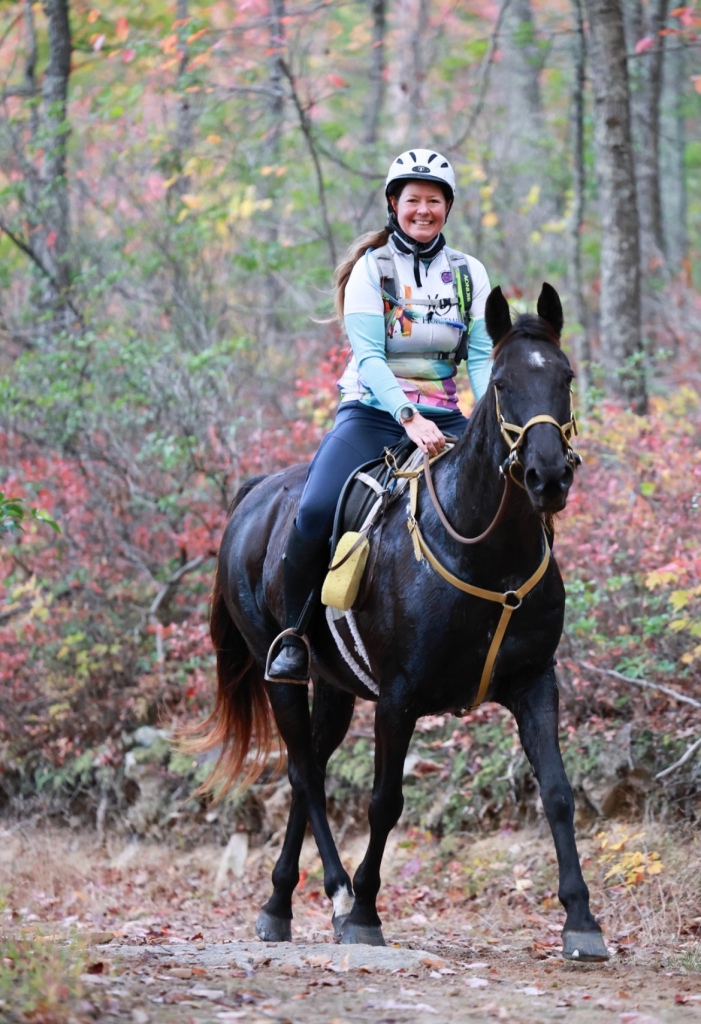
This post on Hope Horsemanship shares the details of the final ride of the season… the ride video, and what’s up next.
Check it out here:
And don’t forget if you haven’t already – subscribe to the HH blog to stay updated!
Journey of an unstarted horse to a 100 mile endurance race.
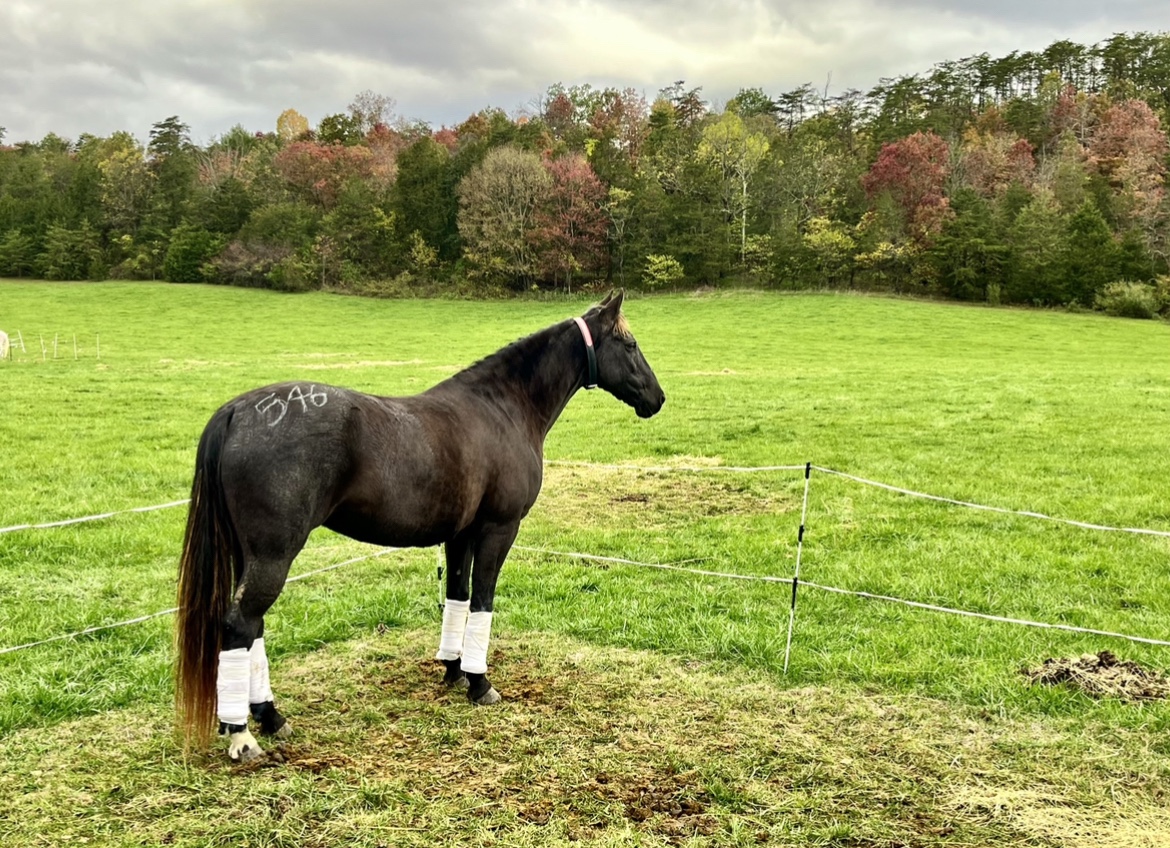
Hi greento100 readers…

This post on Hope Horsemanship shares the details of the final ride of the season… the ride video, and what’s up next.
Check it out here:
And don’t forget if you haven’t already – subscribe to the HH blog to stay updated!
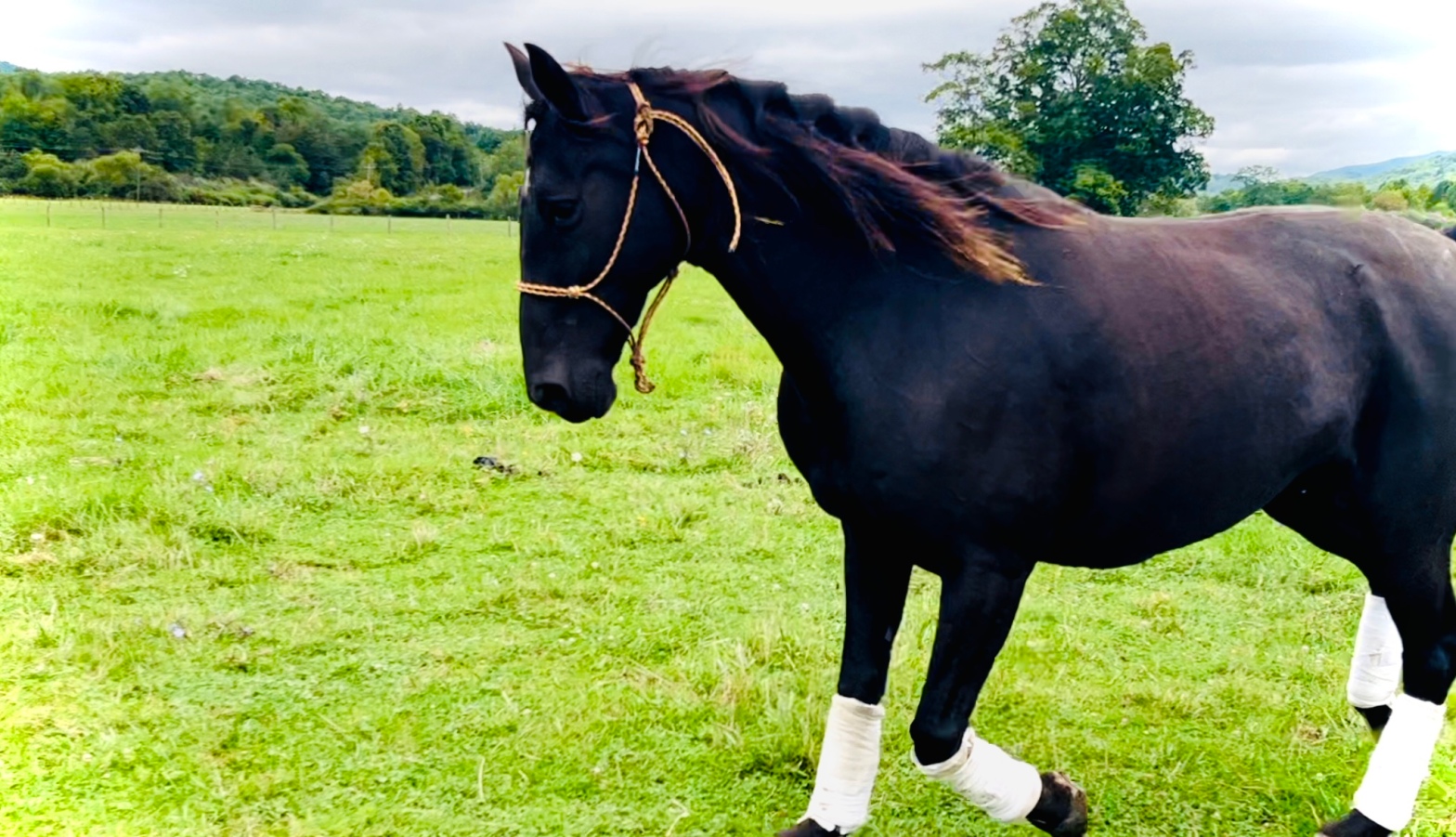
Hello Green to 100 readers!
I have moved over to exclusively updating in the Hope Horsemanship blog- but there are still some of you who are either new subscribers, or you’ve not switched over.
Khaleesi and I have just returned from the Biltmore Fall 50 mile ride and I shared some take-aways and general notes from it that green readers might particularly appreciate. Below I’ll give a few paragraphs of the post and a link to read the rest if you’d like to catch up on the HH link.
Last weekend I went solo to the Fall Biltmore ride. I suppose Khaleesi might have something to say about calling it solo since technically we went together, and she might even contend that she’s the one who counts. Regardless, I hadn’t initially planned on this ride when mapping out my tentative calendar, and as it approached, and I kept seeing no reason not to go, my usual crew were all otherwise engaged. I used to ride crew-less fairly regularly years back and it seems the Biltmore is a good ride to take on without help since the vetting and crew area is the same throughout the ride and is near camp. Thankfully, Brandea and Abigail live in the area and though they weren’t available to crew on the Saturday, they met me in camp Friday afternoon and helped me get the crewing area set up.
Biltmore is a “fun” ride for us so to speak where we aren’t so concerned about each minute counting and being concerned for the clock. The difference for us comes down to the footing. There are tons of loose rocks dispersed around gravel roads and paths, but no rock climbing or embedded rocks in the wooded areas that slow us down. The elevation, though it adds up, is never a five mile grueling climb over a mountain. Rolling hills take their toll, but the climbs are reasonable and followed by a recovery plateau or a downhill in short order.
Our last event was the Old Dominion (OD) 100 in early June and most of my readers might notice that the summer has been spent on the herd with more focus on Wyoming than Khaleesi, so with a few exceptions here and there to get her out for a hike or a ride, and the fabulous Harry Whitney clinic in August, she’s been on a break. I thought this ride would be a good prep for the (Old Dominion Series) Fort Valley which is more challenging due to the infamous OD rocky technical terrain and the trail of tears climb that historically happens in both the first and second loop up the rocky side of the mountain. I wasn’t sure what I would find as she increases in fitness and strength over the years so the Biltmore would give us a dry run, revealing what we were going into the fall with under the hood.
Considering we were in the front third or so of almost sixty riders, I didn’t have much to worry about finding other horses going out on trail. We were released with a couple other riders, and there were a couple just behind. This seemed set up well to help us motivate out into the long middle loop, and if we could just get past the magnetic thought field of base camp I knew she’d go along fine. Or so I thought. Within a few steps, we began to trot along with the small group and to my horror Khaleesi began limping at the trot. This was not a questionable, am I imagining she might be off, this felt practically three-legged lame. We walked a few steps and tried again only to find the same limp and immediately dismounted.
To read the full recap click here.
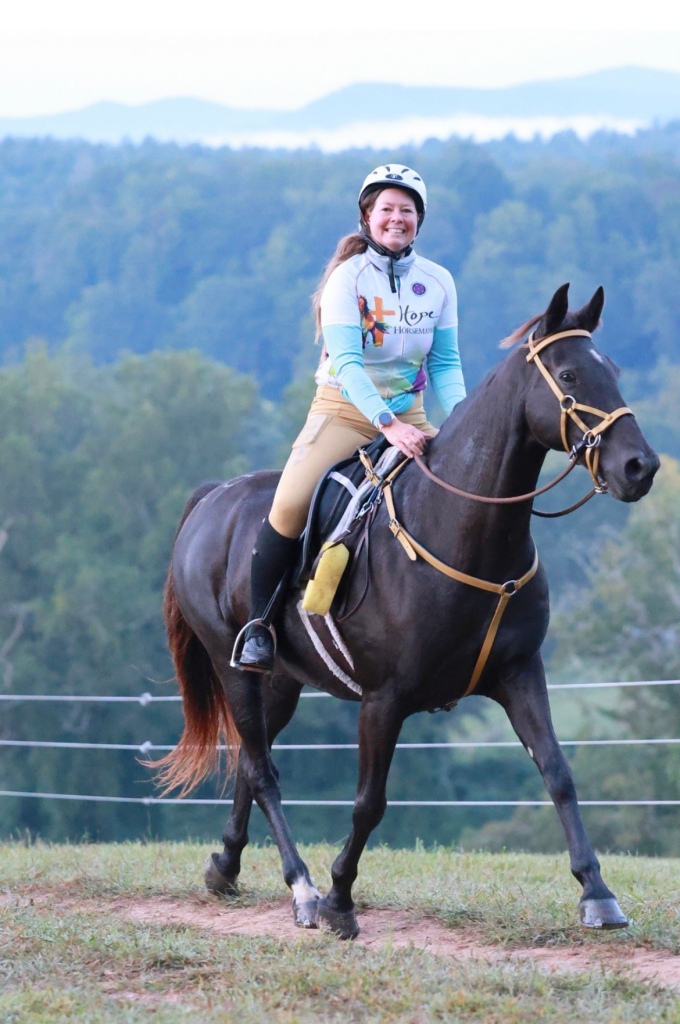

This blog post is number 312!
I almost titled it that, but for a closing post on an era, a simple number felt hollow. I considered things like “the end” or “well we did it” or “that’s all folks,” and those seemed too final. “What next” seemed boring. Then I heard the iconic voice in my head of good old Buzz Lightyear and thought, why not? It’s as good an ending as I could imagine since it calls for exploration of the next things “beyond” and that is exactly what I’m looking forward to opening in the next chapters to come.
Not only has this blog green to 100 been an account of my journey in the last nine years toward the single-day 100 mile ride, but it’s also been key in my writing journey. I hope in the future to find the time to begin going back through the posts and even pulling out or post-editing some of them to begin to create more of a through-story out of what has been quite a meandering trail. Maybe it will shape up into something more of a story… maybe not.
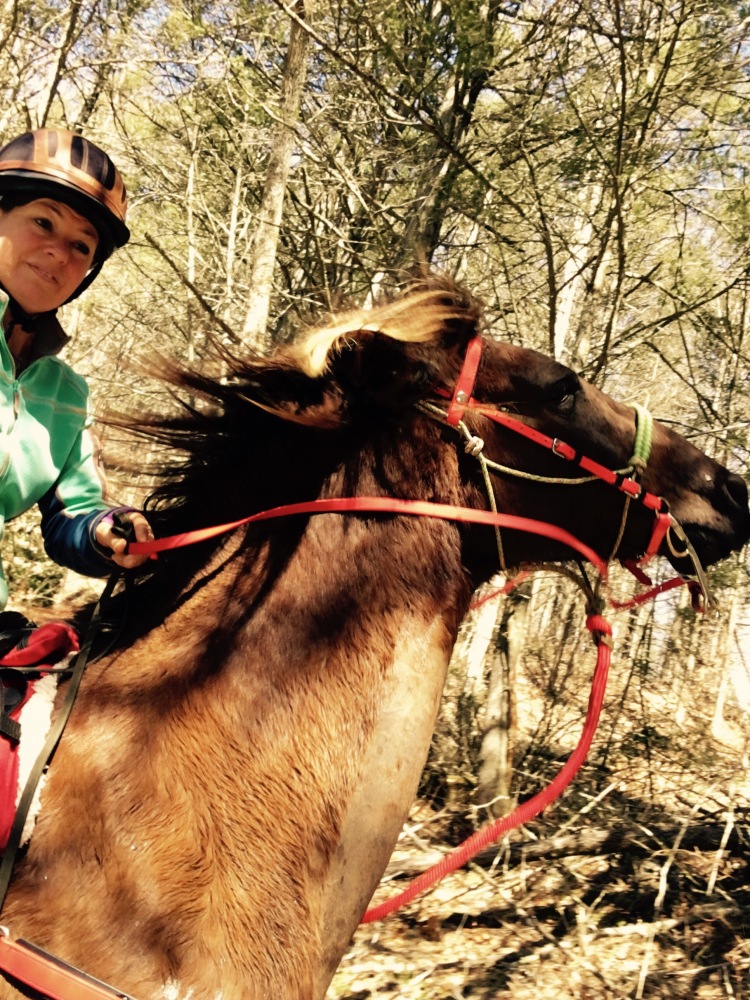
Regardless, besides developing my riding, I also continue to develop my writing! Today I have a published book questioning many of the cultural messages that did not help me in a difficult season (The Jael Finishing School for Ladies: Etiquette for Dangerous Women), it’s available on Amazon. I also keep a blog on that website (JaelFinishingSchool.com) related to life lessons of a more spiritual nature not necessarily relating to horses. Over the recent years, my deep dive into horsemanship has brought many opportunities to process in writing, I have that material at HopeHorsemanship.com.
As I wind down from green to 100 now, I plan to put more focus on my writing in a broader horsemanship sense, and the lessons and adventures I have in endurance riding will fold into that bigger tent. You can continue to follow those all at Hope Horsemanship.
Currently I am experimenting with ways to help my BLM Mustang mare Wyoming start to feel better in her whole life experience. I’ve had her seven years and so far I haven’t been fully successful in helping her to find peace among us. Considering re-releasing her into the wild is not possible, and truly her life would not be a bed of roses in that way either, I’m determined to continue to improve in my understanding of how to help a complicated horse to come to a better place. A sample of that blog for those who aren’t yet receiving HH updates is here: Complicated.
I love endurance riding. I have plans to compete again later this season, and now that we have completed our first 100-mile distance, I’d like to continue to pursue and improve at that distance (if my horse is ready and willing) though at the moment I can see myself most likely planning maybe one a year. I don’t anticipate beginning to do them as often as possible. I have a lot of other hopes and dreams in my horse’s lives besides the single-day 100 now, though I love the true test that distance brings.
I love the true test of the sport because what I have a passion for is the process toward building powerful horses and powerful people. I believe if one takes the time to develop the whole horse from the inside out, then you become pretty unstoppable in whatever you decide to do. An endurance horse is probably limited. [I say this because of the amount of conversations I’ve been in or read/overheard around race brain, the inability for endurance athletes to relax into a casual trail ride with non-endurance friends, the amount of people who have remarked that their endurance horse only loves the trails and “hates the arena”, or the limitation physically with a horse that can follow a trail, but isn’t responsive at following a different thought, or can’t stand still… or can’t go out to ride alone… or is fine unless the buddy isn’t present… etc]. Of course there are shining examples of endurance people who are creating well rounded horses who do not fit those limitations. But to do so can be time consuming and take patience in the process. It is a gift to our horses when we take that time because they become more solid and confident in more diverse situations!
A powerful equine partner is much more interesting to me. When you spend the time to create a connection and real communication with your horse- your language so to speak [this is different than training where you have a ‘push button horse’], you develop a horse that can move relaxed and in balance mentally, emotionally and physically, and that horse is responsive to you as a partner (not simply robotically “knowing it’s job”) then you can do anything together. When you have a healthy horse internally, not fighting inflammation or struggling with heavy metals and toxins, your horse feels better and is able to draw on reserves (not fight through deficiencies) the day it needs high performance to come through any competition in strength.
With every athletic sport, the mental game is a very large consideration. Many high level athletes talk about the importance of visualization and mental-emotional fitness. My observation is many equine endurance riders are leaving treasure on the table by not putting more effort into this part of their training. Horses are big giant prey animals. They are good at putting on the bold front as eons of survival instincts have taught them, but when we get better and understanding what anxiety looks like, we can help alleviate the tension they carry with that low-grade chronic worry in their bodies in tension which causes excess strain on joints, ligaments, and muscles. There are also metabolic issues that can show up as well as adrenal fatigue and ulcers. The horse is pretty adept at masking the mental-emotional system, but the bill will come due later in chronic cumulating physical complications or ones that appear to have behavioral roots like head tossing, refusing requests, excessive “spooking”, or even tossing the rider.
I love this part, sorting out what a horse is thinking and how those thoughts dictate his emotions. That is at the core of Hope Horsemanship. I hope you’ll continue to enjoy the journey with me. For now this includes Khaleesi, and also her herd mates (for now we have Wyoming the wild BLM mustang who carries lots of fears and anxiety [mental/emotional] and Hope the rescue quarter horse who is recovering from EPM and nutrition absorption, toxin/heavy metal load gut issues [phyisical]). I’ll be writing about what I learn in all these diverse horse’s lives as I go- and Khaleesi’s journey will still include endurance events!
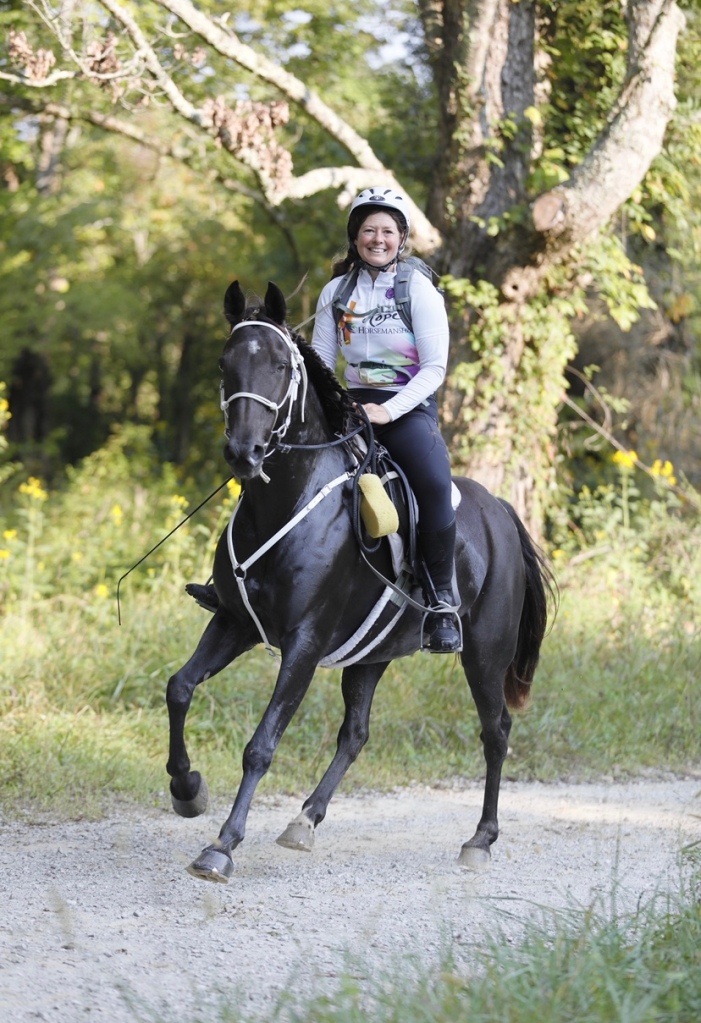
I thought a fun end/new beginning might be to come full circle and share with many readers who have joined in somewhere along the way, the very first blog post I ever published. In this post I have had Khaleesi about six months and muse about choosing her as my horse, and knowing basically nothing about endurance riding and almost nothing about starting a green-feral type horse, I look out in the hope that the journey might get me to a strong horse in a 100-mile event.
Link to Snow-and introduction from December 2015.
Considering my last post was about the culmination of that journey it seemed a fitting way to say goodbye to the green to 100 and welcome anyone who wishes to continue with me… to infinity and beyond!
Subscribe here. hopehorsemanship.com/subscribe/

[Cover image by Becky Pearman from our first 55 mile completion at the Biltmore in 2016 taking us out of Limited Distance and become a “true” endurance team. ]
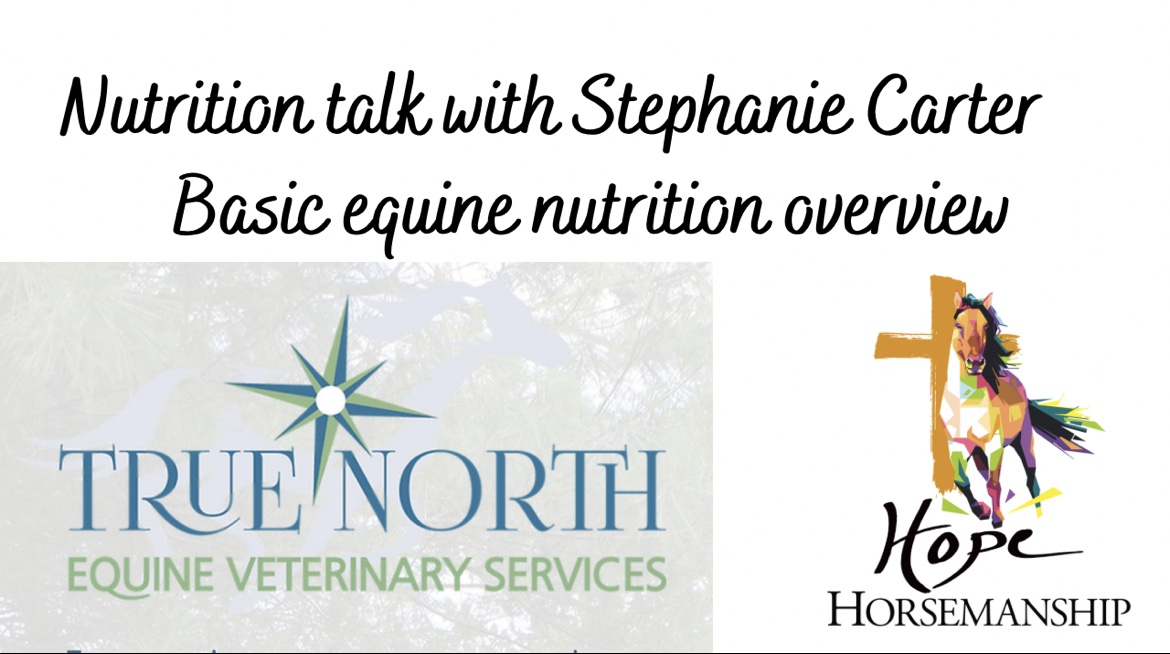
We have been working with Stephanie Carter NTP for over a year to get an individual look at their nutritional deficits, heavy metal loads, and ways to support the horses for better health and performance.
Supporting Khaleesi on the cellular level has been key for us getting through our first 100 mile event. I had for years been on a forage based diet with supplements for micronutrients and had gone through the forage testing and analysis to help manage my dietary decisions. However when a quite sick horse in the herd needed a deeper look, I decided to do the same with Khaleesi and the small but vital things I found made a real difference when I stayed with it for the year.
In Khaleesi’s case we found adrenal imbalance and a zinc deficiency along with troubling nutrient absorption pointing to less than ideal microbiome. She was getting plenty of zinc in… but it wasn’t being absorbed.
First Stephanie helped me get a better balance in her nutrient intake, and we waited months to allow that process to give us its best shot. Then we did another hair analysis which showed better balance but still levels indicating poor gut health.
It so happened while looking for other potential issues in the well water I found significant chlorine and chlorine dioxide toxicity which would account for poor gut health (chlorine kills off the good gut bacteria we were trying to support). In changing the water source over a few months and adding the Organic Gut Solution to help encourage the toxins to move through without taxing her body- I saw significant increase in her ability to recover and thrive with more energy.
Stephanie was able to see that Khaleesi would specifically benefit from additional phosphorus – and that really helped her take a step up. It was the Biltmore ride where we began adding phosphorus and she came in 7th for that ride and finished strong and recovered better than I’ve seen.
We also got an inside look at her bloodwork before and after an event (thanks to the Gut Permeability Study at Biltmore) which showed us that we were on track now and she was fully supported going in- and coming out!
If it weren’t for Hope (the horse needing healing from some serious health complications) I might not have bothered digging deeper as I didn’t see Khaleesi as being deficient, and as far as I knew I was supporting her nutritionally as far as most experts suggest. I’m really grateful we dig deeper because it has shown me where I can help her and without question, she feels better than she did!
Stephanie agreed to have a conversation with us about some basic nutrition ideas including inflammation, adrenal fatigue, and gut health and how to get started looking at the cellular level.
We hope to get a follow up conversation sometime to go deeper into some of these topics! Submit your questions in the comments and we will try to get to as many as possible!
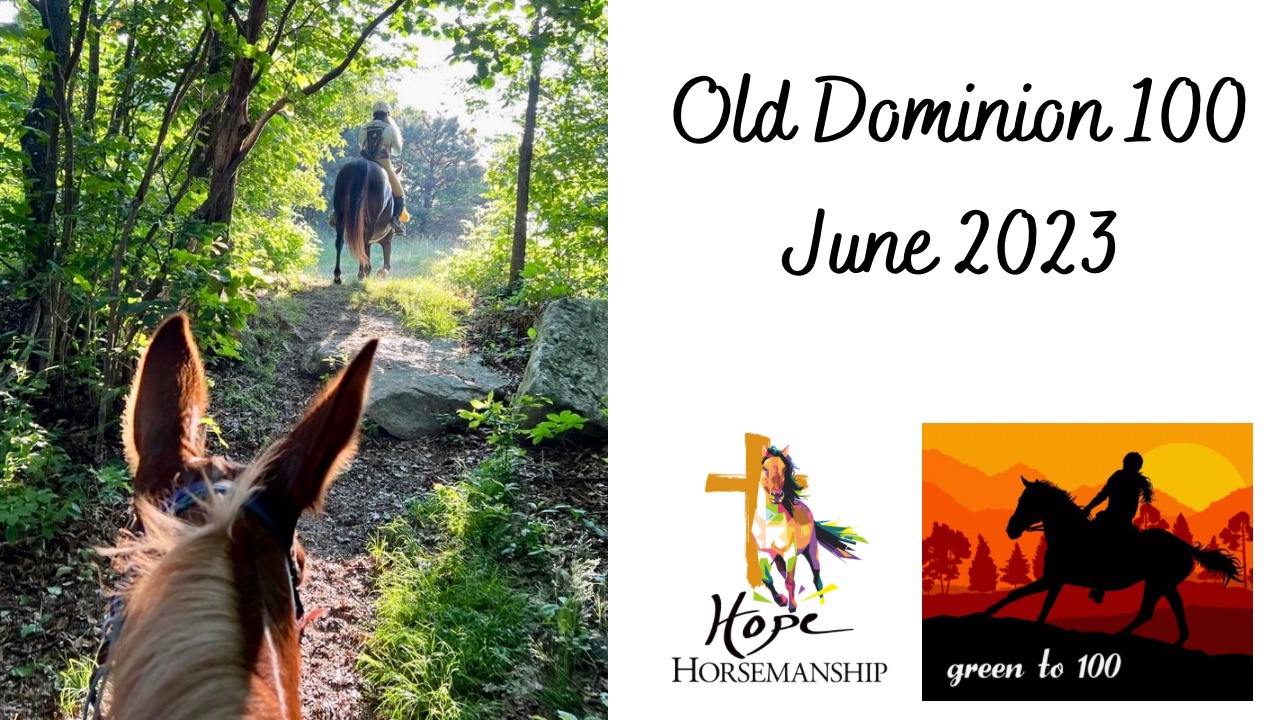
It’s an exciting time for green to 100 having finally taken on the single day 100 successfully.
I hope you enjoyed the write up about the ride in the previous post: Ride Through Fire.
I took video throughout the day and edited the clips into a look at the ride from the inside. If you wondered what it was like to do a 24 hour endurance ride in 20 minutes of clips this video is for you!
Enjoy riding along with us from the night before in ride camp to post ride all the way to unloading back at home.
You can also use the link to go directly to the YouTube channel: https://youtu.be/zxfxX3OzV3o
And stay tune to what’s next for green… not so green anymore.
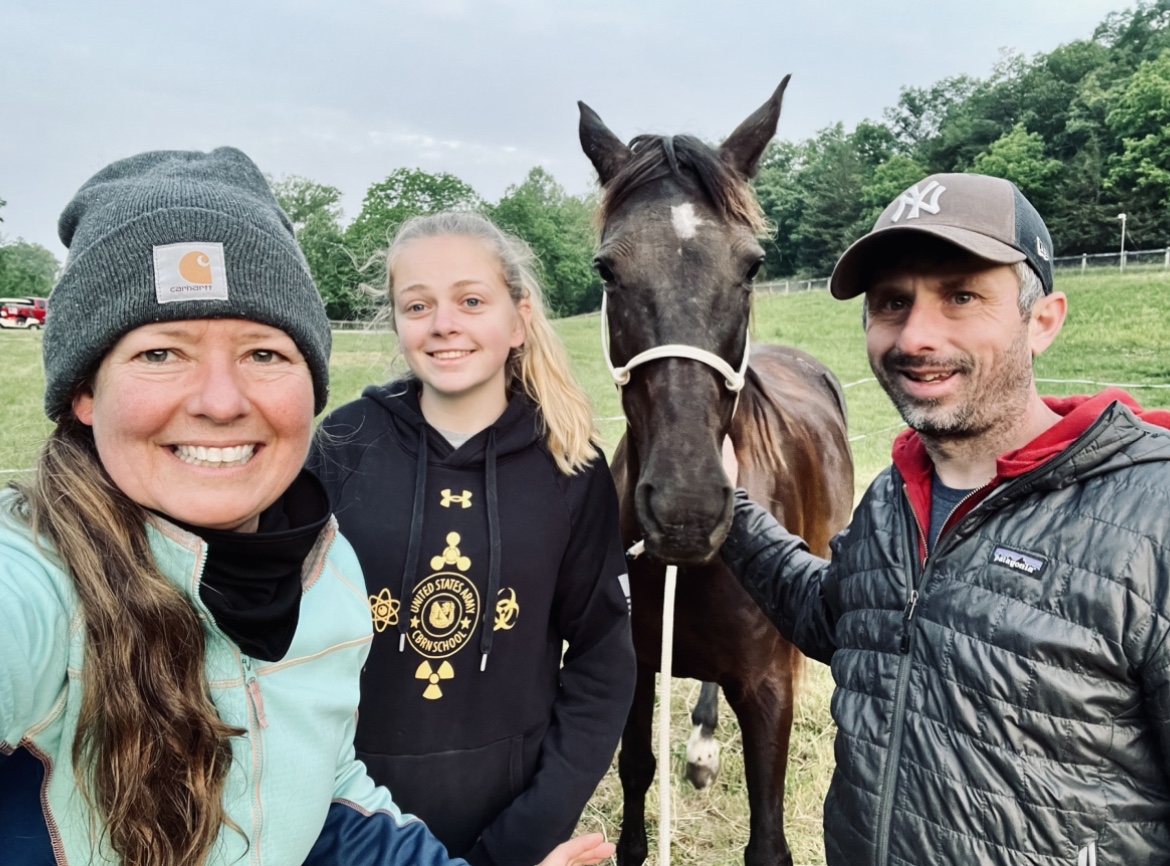
The story of the OD 100: June 10,2023.
It does seem appropriate that the culmination of the greento100 journey, Jaime and Khaleesi would ride through a fire on the top of the mountain.
Every detail of this ride weekend was expertly orchestrated. I should clarify: not that I expertly orchestrated it- that is way above my skillset. It was orchestrated by the one who can orchestrate temperatures, thunderstorms, and fires.
I have to thank my official mentor for most of this journey Lynne Gilbert who along with Kate Lawrence (who has helped me many times with ideas and amazing organizational suggestions and great conversation sharing some training rides) were incredibly helpful in dialing in my prep for this ride. I hate prep and I hate packing, it’s the thing I think I’m weakest and it seems to take so much effort and focus for me to do, I put it off. With their advice, the prep work really paid off! When Iva and I arrived at ride camp we had everything done and settled in a few hours including check-in and vet-in. We found ourselves sitting in our chairs, sipping sparkling waters, admiring the horse eating in her pen and talking about how nice it feels to be so far ahead of the game. Everything had a particular calm about it for this ride- even down to the fact that I had zero truck or trailer trouble (which every other ride this year has had something go wrong).
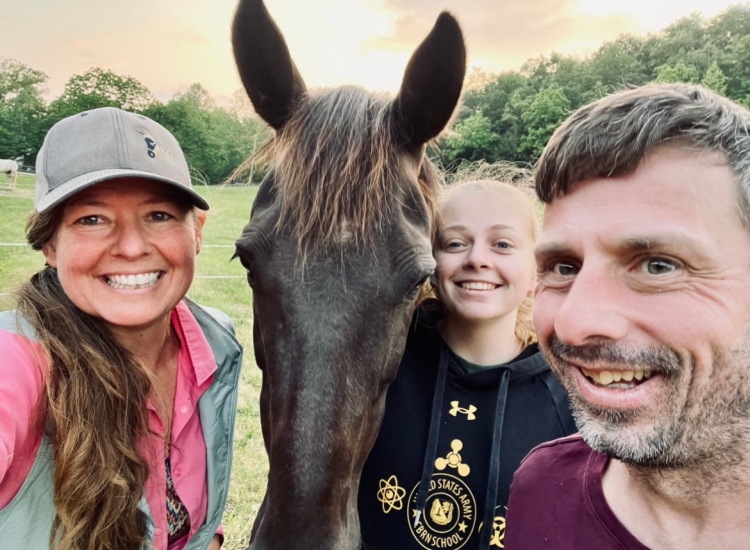
As for the details way beyond my pay grade: the weather was in our favor with highs predicted 78-81 degrees, the low for the ride start was 48 (cooler than I like, but great for K) and the low over night during the ride was in the 50s. Humidity was low as we’ve been in a dry spell, that means trails were dry and no mud to contend with. These details were good for us, but most good things come with a flip side. Dry trails also mean all of the dirt roads were relentlessly hard and concussive, and even more, the dry meant a forest fire had started on the mountain the early morning before the 55 mile ride on Friday. The amazing OD staff (lead by Diane Connolly) rerouted the second loop of the trail after the ride began and before any riders got to that section. That meant they were able to pull marking on the old trail as much as they could without going into the fire itself- and mark with great clarity the new trail that we were assured was “almost” exactly the same distance.
This also I found fascinating that the fire was in the place where there was already an alternate trail ready to go. In fact, when the AERC national championship ride was held at the Old Dominion a few years back this was the section they rerouted for the trail that year. They did not have to figure out a reroute, only to go make the changes. So in fact, we ended up riding the same trail they used for the National Championship ride.
The reroute took out what was in my opinion the worst climb of the day, that happens in the worst heat of the day as well. It’s a segment of trail I’ve done in the 55 mile rides I’ve completed in years past and it’s my least favorite segment. I always get off and walk because the climb is so steep and relentless my horse is never going any faster than I can walk and so it makes sense to save her the effort of also carrying me while I could walk. It never seems to end and when the worst of it is over and you feel like you’ve gotten somewhere, you realize you are still climbing just less steep. Then when you begin to descend it’s steep and lots of loose rocks, so my horse slips a bunch on the footing. Last year I got back off and ran down the mountain on foot so we could make up some time and go faster than I would be safe riding it.
The new route still had to go over the mountain, so it didn’t save us elevation, but it had a different way to do the climb that I thought was a better route for the up side… The problem with the reroute is it left us all with 7 miles of downhill gravel road that was dry as bone, slippery with loose gravel and concussive without a break. The route apparently weeded out a fair amount of riders on the Friday 55 with lameness issues at the Laurel Run vet check and we were all cautioned to take it easy on that deceptive stretch of road. The last half of it was pretty steep downhill as well which was particularly difficult to get much speed if you didn’t want to risk injury.
I thought for my own horse, I’d take the gravel road over the climb from hell any day of the week, but was surprised to hear every single other rider say the reroute made for a harder segment and they were not happy about the news though everyone knows you can’t argue with a forest fire. The general consensus was the ride this year was particularly tough due to this issue.
Regardless, this was all out of my control from the weather to the fire, so I went to bed early (since we had everything so well dialed in) and didn’t sleep hardly at all.
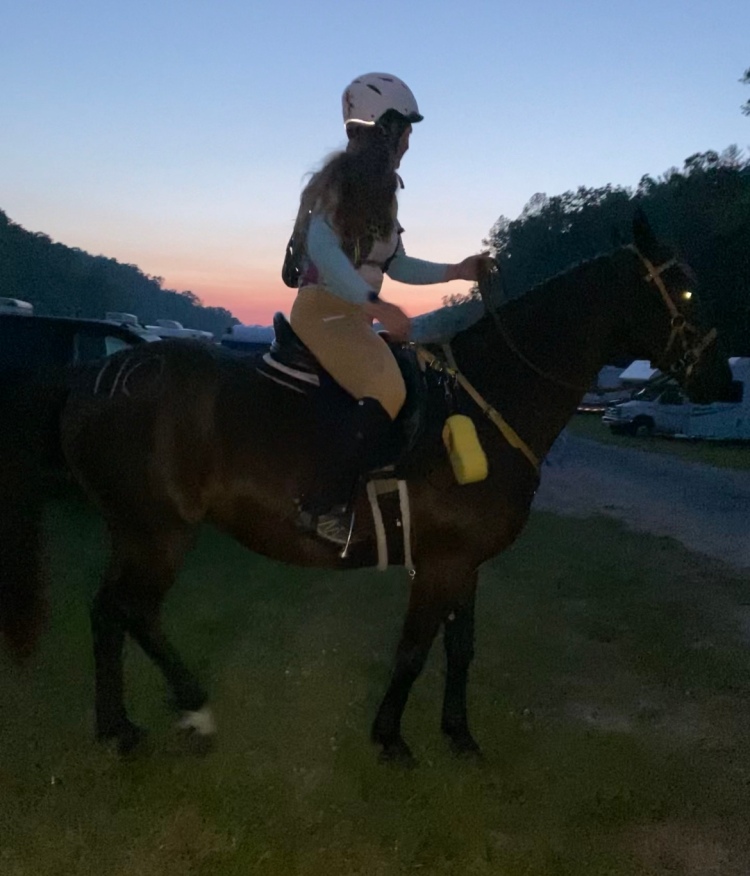
By the time 4am came around it was down to that cold 48 degrees and I really did not want to get out of my sleeping bag cocoon. I made the decisions to sleep in my riding pants because it made getting up just a little easier and was glad I did. Mike worked on the coffee, Iva took care of the horse including getting her for a light walk around camp as I got myself ready to go.
The day began with high drama as right before 5am we had a stampede of loose horses thundering through camp- unfortunately some of them with their temporary fencing behind them which makes for terrified horses everywhere. I am glad K was walking with Iva instead of in her pen, however that also held some dangers as loose horses terrified and in flight do not make good decisions and could certain get Iva and K caught up in a mess.
I found Iva nearby slightly entangled with a loose horse, but K was calm and Iva was ok. She is about as cool as any cucumber I’ve known, but I think her adrenaline had shot up as I took the lead rope from her and began to intervene in Khaleesi’s attention— asking her to focus on me, trust me that all was going to be well, and she could relax and let go of the crazy stuff that was now just calming down as people began to get their hands on the wild horses around camp.
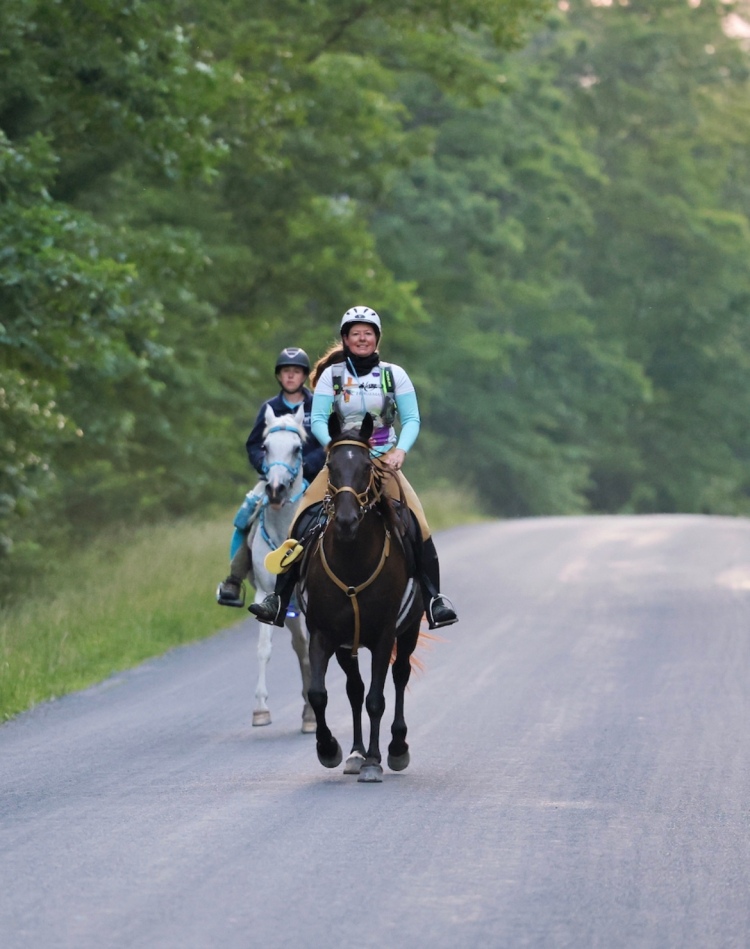
We were checked in with Henry (the man in charge of all time) by about 5:25 and walking back and forth on the dirt road getting focused and prepared for the 5:30am start. There were 13 horses and 1 mule that would cross the start line as the sun was just coming up, 10 of which would cross the finish line sometime the following morning.
Our first loop to Bird Haven 1 was uneventful and I had hoped to do the segment in 2 1/2 hours. We came through the meadow to the in timer at 7:55 am with a ride time of 2 hours 25 minutes. By 8am we had crossed the pulse window easily at 52BPM and were vetting through with no trouble and a recovery pulse of 48. The morning was cool which really helps a dark muscular horse. My crew took care of everything and got us out on the second segment at 8:40 not to see me again until we reached the Bucktail check at 4:09pm. Laurel Run check lies in between and no crew is allowed there the first time so we would be on our own the next 7 hours or so.
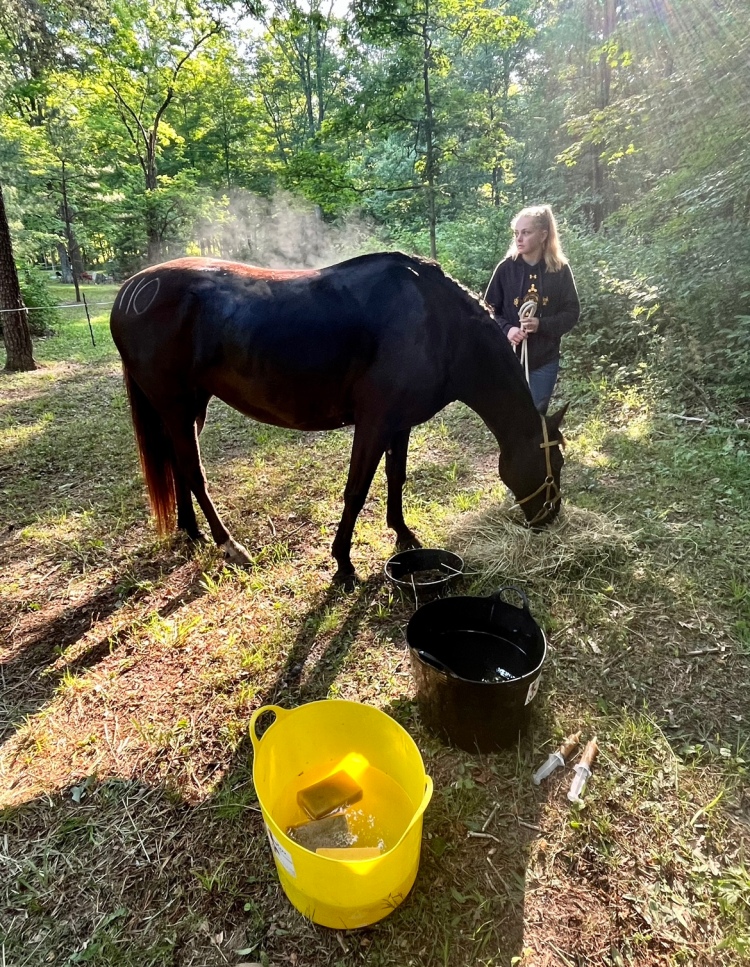
This was the rerouted second loop, and the only time I went (briefly) off trail. This was one thing I really wanted to try to improve as it seems at almost every ride I miss something. It really costed us at Big South Fork where it is possible we MIGHT have finished had I not added 6 miles in the wee dark hours following the wrong colored lights at a trail crossing. This time instead of it costing us, it might have paid off because after I passed a turn, realized within maybe a tenth of a mile there were no ribbons and an intersection with no direction at all we had missed something… when I went back I saw the turn (there was a camper parked near there off in the woods that had distracted K. I missed the turn because she was so focused on the distraction I had gotten focused on helping her move past it, when actually turning was what we should have done…) I began to head up the correct trail again and came quickly upon Nancy Sluys and her fabulous mule Danny and from that connection, we didn’t part ways until the finish line.

I had prayed for a few favors for this weekend. One of which was favorable weather including no thunder storms, the other was a buddy to ride with so we would not be in the back alone, spending all those miles of hard trail in the wilderness never seeing another soul. I was prepared to do this ride in any weather, and I am always prepared to ride alone, but having both of those prayers answered was a grace I am thankful for.
Nancy manages and runs the Iron Mountain ride and has completed the OD I believe about five times in her career. She has both come in top 10 and come in turtle (the coveted last place) over those years. On this ride she was purposely taking the long, slow journey to use up the clock as a resource with a mule she felt likely could do the ride, but he wasn’t as conditioned as she might like. She was going to take good care of him and not push him more than his tough mule system could thrive. Doing our first 100 with a mule was fitting somehow, certainly it was divinely appointed because that mule ate every blade of grass he found out there, and the frequent stop for a quick bite encouraged K to eat a ton along the way; and his determination to walk EVERY SINLE HILL NO MATTER HOW SMALL THE INCLINE saved our strength and got us through each vet check with flying colors. I think it was mule magic that gifted us such a strong finish for this first 100 completion for us.
It was true the last 7 miles of hard packed pounding dirt road of this segment was concerning. We trotted when we could and took care not to pound too hard too long— but also not walk it all which would take forever. When the road got steep, probably about 4 miles to Laurel Run I dismounted, loosed my saddle slightly, rolled up the stirrups and committed to jog the final section in myself. I hike and jog with K all the time so this is familiar territory, however I ended up on foot longer than I’d have chosen if I realized it. I took on a downhill jog of 6-8mph which I hoped would save the pounding on her legs not adding my weight to hers. The ride photographer Becky Pearman (who is amazing in every way) caught us in the last 1/2 mile to the vet check jogging in together which is fun because I now have a photo memory of that- which turned out to be the only part of the ride I did on foot.
I jogged all the way to the in timer at Laurel Run at 12:18pm. This is one of the two toughest trail loops now in the bag. We traversed the distance in just under 3 hours and 40 minutes (just what the distance was I’m not sure, I was told the reroute trail was the same distance as the original route- 16.5. My Strava record suggests it was a little over 19. I know these things have variable accuracy- and I am certain I did not go more than 1/4 mile of trail. Regardless we made it!). We pulled tack and were pulsed in up the hill 4 minutes later at 44BPM, sound with all ‘A’ scores, pulse recovers to 48 and an out time of 1:07pm.
Nancy and I left Laurel Run together to take on the big gravel road we had just descended toward my favorite loop of the day. This is the ride to Bucktail and thanks to the awesome drag rider program that Duane manages I’ve already ridden it twice and knew what to expect. Being a favorite doesn’t make it easy. It begins with a four-mile relentless climb in the sun and heat of the day. Then we head into my favorite scenery of the ride- beautiful grass trails and single track through pretty woods. There are no serious climbs after the gravel road, but there are plenty of rocks.
It’s a bit deceptive because the grass trails look so inviting and ready to take a carefree trot or even canter through, but the trails are embedded with rocks that are easy to trip over or land wrong on if you aren’t taking care. The loop is listed at 14.5 miles- the shortest yet of the day- but it still took us 3 hours (and 2 minutes) to get through it. Thankfully a bonus perk to riding with Nancy is she sings some of her original songs about endurance riding! We actually spent some of this loop singing to each other to pass the time.
We arrived together at Bucktail glad to see Mike and Iva waiting for us at the in-timer at 4:09pm; within 2 minutes we’d pulled tack at the water troughs and pulsed in the heat of the day with minimal sponging at 64BPM with a recovery of 60. The Bucktail trot out lanes have landmines of rocks and debris in them and K and I both found ourselves tripping out and in! The vet said she saw some potential off steps but she was thinking it was the surface not an injury- that proved true but gave Iva the job of butt massage through that hold to ensure she wasn’t getting tight. Everything else was good to go and we headed to the truck where my crew had set up everything for us for the 40 minute hold.
This was the first vet check that K began to prefer browsing for grass over her prepared food. Iva had to massage in between K walking casually up and down the lane looking for her favorite spots to graze. Bucktail isn’t the most friendly for grazing being more of circular drive than a field. Still she was actively eating and seemed happy with the plan so we allowed her to make the call for herself. I found snacks myself- preferring pretzel chips and a homemade cream cheese dip along with a sourdough pizza pocket with sausage and mushrooms.

We were ready to go at our out time though I thought I’d lost Nancy and Danny and almost considered leaving without them (only because I couldn’t actually find them). Turns out they hadn’t pulsed quite as quick as K due to Danny dragging Nancy to the water trough and drinking for about two minutes straight upon arrival. We ended up waiting at the out timer until both horses were released (5:01 for me and 5:07 for them) and we headed into the next segment which included the horrible horrible trail that we’d ridden in deep discouragement in April at the No Frills 55… the trail that had turned my mind right then and there never to attempt the Old Dominion 100 because I never wanted to set hoof on that trail ever again…
We were headed there now: the longest distance of the day (almost 24 miles) until we saw our crew again at Big 92, but broken up in between with what is called a “gate and go” as well as a “hospitality stop”. The first part clocked on my GPS recorder at 7.9 miles and was mostly open forest roads, but with that hoof crunching quartz rock that you cannot move much on. It is terrible for footing and slows everything down. It also had over 1,000 feet of elevation gain and brought us to the “gate and go” called Waites Run at probably just after 6:30pm (I didn’t attend to my electronics right away at this check and I’m doing backward math for this estimate).
At the gate and go you enter the checkpoint and you get an “in” time only when you come down to pulse of 64. This is the “gate” of the gate and go. As soon as a vet calls your pulse time the “hold” clock begins and you must wait 10 minutes, allow your horse to eat and drink, then you’re back on the trail again. There is no crew here, it’s a brief pause for the vet staff to be sure everyone is still doing well and make sure everyone is ok on trail. Though there is no crew they make you a freshly grilled made to order hamburger (with cheese if you want!) and I ate one! There is cold water (was so refreshing!), and they offer your horse a small variety of snacks including carrots, and will hold your horse so you can take a potty break.
Out of the 4 of us that entered together coming in at a trot since the terrain allowed it, I checked in immediately at 72BPM. After about 30 seconds another check had us at 68… then a third check in about the same time or less had us down to 64 and we were the first to pulse down and get an out time. The team that had caught up to us on the trail and spent the last couple miles riding along came down next, but Danny was hanging high. In this case they quickly made the call to pull off the tack (saddle and pads) and get some cool water on him which helped, but it cost maybe 7 minutes or so to get his temp and heart rate to drop. Danny seemed to hang in the 70s but once he dropped tack and got some cool water he dropped like a stone into the 50s.
This was when I had a decision to make, and now looking back it wasn’t really a decision, but in the moment I did weight my options. I had the first out time and I could leave alone and get back on trail asap. I could go out with the next rider who was just a minute or two behind me… or I could wait the 7 or so extra minutes and stick with Nancy and Danny. It didn’t take me long to weigh the possibilities and I made the call for good that we had partnered with the mule team, and we were now in this together. We would wait. It wasn’t simply magnanimity that drove this call. I believed that they were the right partners for us for this ride. So K got a few extra carrots and I ate my whole burger and we let the out timer know to just hold on, we’d get out of there when the mule was good and ready!
I think we trotted out just around 6:53pm with the blessing of the vet who watched us go (that’s the “go” part of the gate and go, our departure is like a trot out so the vet has to see we are sound but they do it as we are leaving- calling you back if there is an issue), it’s like an abbreviated vet check.
Now came the infamous Old Mailpath Trail which is the section I consider the most horrible. We had just climbed 1,000 feet in the first 7-8 miles, and the next section added on another 1,800 feet- all of it on unfriendly technical terrain. The “mail trail” as it’s endearingly referred to is not actually that bad if it were that climb alone; but after you’ve had about enough of it, then you exit the rocky climb for the demoralizing Tuscarora-Three Ponds Trail which is more of a rocky mess of climb heading over the top of the mountain and starting down, which is no faster because the rocks and terrible footing. Finally you come to the turn off to Little Schloss Road, which isn’t really a road at all… and for us it was now dark enough to turn on a headlamp, and the rocky chunks of “gravel off road” road were tough to push through in the gathering darkness. Khaleesi would get a little speed going and then trip or slip or hit a rock and with the intelligence she possessed would suggest strongly that we should continue to walk. Danny was always incredibly sure footed, but he was never in much of a rush to get anywhere, so he picked his way through it all beautifully but not with incredible speed.
It was in this gathering darkness and the demoralizing slow as molasses pace we had been going practically since leaving the Waites Run Gate and Go that I was beginning to panic. The estimate to get to the hospitality stop was supposed to be around 12 miles and in the end my GPS showed 14 (I realize the GPS are not all accurate but it can be frustrating when you’re getting worried as the hour is getting late, the mileage is adding up and still… you are not there yet…). The horses were feeling the drag and becoming hard to motivate. This is when the voice was coming out of the darkness why did you wait at the gate and go? You should have taken that few minutes and gotten ahead… you should have gone with the other rider… This mule is determined not to finish this ride, all he wants to do is walk and eat! How do you know you can trust Nancy- she seems confident it’s all just fine, but she could be fooling herself! What if she’s wrong… You know you are never going to do this 100 mile distance! You should have gotten an Arab that runs over the mountains and rocks like it doesn’t care if it lives or dies instead of this horse that refuses to do anything she deems “unsafe”… You guys will never make the cut of for Big 92. You’re going home in a trailer.
I told myself to quit it. This is NOT how I live. Even if we didn’t finish I decided to do it with our friends and that was more important, remember? Remember what matters? Not completing a ride and achieving a goal! What really matters is all in the how we do things. What really matters is the who that’s around us, not the goals we want to achieve. I told the voice in the darkness to go away because it didn’t matter now, I had made my choice, and I was with the mule for better or worse.
And that’s when a pair of riders from behind came up on us like a freight train.
They had realized how behind they’d gotten and close to the cut off times, and were attempting to make up some time. The sound of horses scrambling furiously through the rocky road and lights coming brighter had our animals on high alert. Khaleesi was in a slight panic not sure what was happening, but certain she didn’t want to die there on the mountain so she picked up her pace. Danny was slightly less panicked, but he was getting motivated and adrenaline was kicking in like a drug. The pair from behind began to push (inadvertently) on our demoralized mounts and they began to decide they maybe could start to pick up the pace. We stayed ahead of the riders for a bit, but they were overtaking us and eventually asked to pass. Which of course we said certainly.
This woke something up in our horses (I’m not sure if they wanted to keep up with the other steeds that passed, or if they didn’t want to meet whatever had them running through in such a panic!) regardless they began to pick their way at a much faster rate through the dark rough trail-road and we scrambled along behind the fast moving pair, I for one, was glad to be moving again and then prayed no one would break a leg on the loose rocks as Khaleesi occasionally tripped slightly or slid but never enough to fall or cause injury.
This went on what felt like endlessly. I’m sure it was like 6 hours…. (Ok maybe it was 15 minutes?) …past my mileage estimate and at that point I had no idea when we would find the hospitality spot which had a cut off time of 10pm. Finally we saw lights ahead and we pulled into Little Sluice Hospitality stop at 9:50pm. Nancy was pleased- we have 10 minutes to spare!
This did not encourage me.
I did not want to do this ride on 10 minutes to spare. That felt a LOT too close for comfort!
A hospitality stop on an endurance ride has no minimum hold time. You get to see a human; they check your number and report that you are ok (or if you are not ok!). They have cold water (what a treat) and water, snacks and carrots for the horses. They’ll hold your horse while you pee (also a treat) and you can relax there as long as you wish. For me, that as long as I wished, was as fast as we could get a drink, take a pee, and get back on the road.
In my mind we were now racing the clock, or admitting defeat. The final stretch into Big 92 was 4 miles and we had a cut off of arriving there and being pulsed in by 10:45pm. Looking back, doing 4 miles on a clear dirt road, mostly downhill and having almost an hour to do it was not exactly pushing the clock, however I was feeling the pressure of the ticking hand of missing the upcoming cut offs and I basically made the call for “us” that this was a quick stop and off we go!
Nancy was graceful (I learned today Nancy means grace… how apt…) and she humored me as I rushed her onward and we left before the riders that had passed us- getting quickly back on the trail by 9:55pm.
This next four miles Khaleesi and I drove a relentless pace with occasional waiting for Danny who decided a slight incline is technically uphill and oh yeah right he doesn’t trot uphill. Once in a while he would grab a bite of grass, but I think he realized Jaime was starting to come a tad unglued and maybe he wouldn’t push his luck on the salad bar just then. Mules are smart you know. As the miles began to pass by at a faster pace, I began to relax… but not fully. We were eventually passed by the other riders who we’d leap frogged at the hospitality stop but we still made great time on the 4 miles in 32 minutes to pull into Big 92 where my crew was waiting with arms open wide at 10:28pm (now 17 minutes to spare, so the gap was widening a tad). We were now at mile 70.
I walked K to the truck in order to pull tack and that took a few minutes since the truck was not close to the in timer or the vet. By the time we walked back over to the vet, looking back I think it was more time wasted than I’d have preferred. [I think in the future if we couldn’t get closer with the truck, I’d have my crew bring a bucket and sponge to the front area and I’d drop tack there, like we did at Bucktail.] With a 6 minute lag which was the longest all day from in timer to pulse time, and the furious pace we’d come through in the last 7 miles or so, the patient pulse taker held on as she gradually dropped (K was closer to 68 when we first arrived then dropped to 60). Straight to the vet who read us at 64, and after a jog out and back recovered to 60. That was all acceptable, however Dr. Bob (who has known us for many years) thought her gut sounds were quieter than he would like and at this stop our card was held for a recheck before we left.
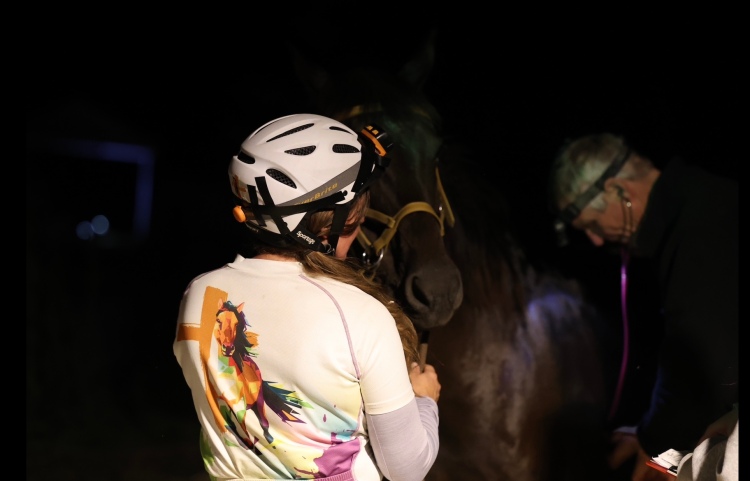
We could all see that K was attacking everything green she could while we talked and observed her. She was hungry, eating well, and drinking (her hydration was excellent). He didn’t think there would be a problem, but he wanted to be certain before we left, so her job was to get eating so he could hear the guts begin working again before we would be released. This didn’t affect her out time unless the gut didn’t start moving.
Back at the truck, Iva now had the job of allowing K to eat everything and anything in sight, which she did, preferring mostly grasses and weeds to her prepared food, though she did eat some of that as well, and some hay, carrots, and an apple.
This was my grumpy pants vet check. I told my patient crew that I was worried about the cut off times, and how close we were getting to bumping up against them. The slow pace we had been stuck in for, lets face it, all told like 30 miles in the last two segments, was wearing on me and I felt like we had no chance make the finish line. I was grateful we were getting to go out again, because even if I only made it to the second Laurel Run and then got pulled for missing the cut off, at least that would be almost 80 miles and I would have seen the entire course for the next time I try this thing again… because it was is a question of when we finish this ride, not if. And at that point I was about certain it was not going to be that attempt.
I tried to be gracious to them and all they did for me. I think I said thank you 50 times although it was because my black little heart did not feel thankful at all right then so I was overcompensating (I WAS thankful for them of course just not the position I thought I’d put myself in to not finish this thing which when you’re also on lack of sleep you also feel like your crew came all the way out here to support you the least you could do is get the thing done so they could feel like they came for some purpose, not throw it away by making dumb decisions that cost time when you maybe should be taking the advice of everyone who says RIDE YOUR OWN RIDE… all of this is nonsense, but it was the low point so I just had to get through it) Mike had heated up some of his amazing famous home made mac and cheese, and I could only eat two bites. I felt terribly ungracious all around. I was getting queasy from the stress.
The only rule I’d made for myself was not to ride a slave to the cut off times. Not to be anxious, but do my best and accept what came. Now that the composite shoe hit the road, I was completely stressed and anxious over the cut off times! This was exactly what I wanted to avoid, and here I was caught in the trap.
There was a call from deep in my heart that at the end of the time at Big 92 that over-rode everything. It came from the remembering that truly I never doubted that I made the right call. We were in it with the mule team, and I knew it was right. It was like being tied to the mast when the sirens were singing. There was not a question that I was doing exactly what I was meant to do, but the crazed part of me still fought against the restraints I had put in place myself. Thankfully, somehow I did get a hold of myself. I took K over to the vet for a recheck on her gut sounds and sure enough they were back to good and we were given back the rider card with blessing to continue. We got the mare saddled, electrolyted and walked over to see Nancy and Danny just finishing getting ready for their out time which was a few minutes behind mine.
As she was doing a final check of tack I asked her: Nancy… do you really think we can finish this thing?
Not a question. She replied
Like, not a question we can’t… or like not a question we can? I really wasn’t sure I understood because it seemed to me also to be certain… certain for failure at this point…
And with that it was settled. And I believed her. We had 30 miles to go through the night and we were going to finish this thing. And with that I had peace again. And with that peace we rode out accompanied by the drag rider coordinator, Duane Martin, to do the fastest segment in the ride.
We left Big 92 around 11:21pm and arrived 8 miles later at the second Laurel Run checkpoint at 12:32am, 70 minutes later (roughly 7mph average). The in-timer is at the bottom of the hill, walk up half way to drop tack, and then without a sponge of water – seeing Danny and his crew going straight to vet- we followed suit and immediately walked up the rest of the hill to the pulse and vet. That (much of it being walking) took 4 minutes to get a pulse of 56 after a fast pace and uphill climb to be checked in. Her gut sounds were fine (considering we didn’t eat much on the road race to get here that somewhat surprised me) but this was her first line up of ‘B’ grades for gait, impulsion and attitude. Well, Laurel Run is famous for having a rocky down then uphill trot out, and we’d just run a pretty fast 8 miles, so, I think that’s fair. She was less than enthusiastic and who could blame her now at mile 78.3 having left camp 18 hours ago. Otherwise her score card shows all A’s and she was cleared to go.
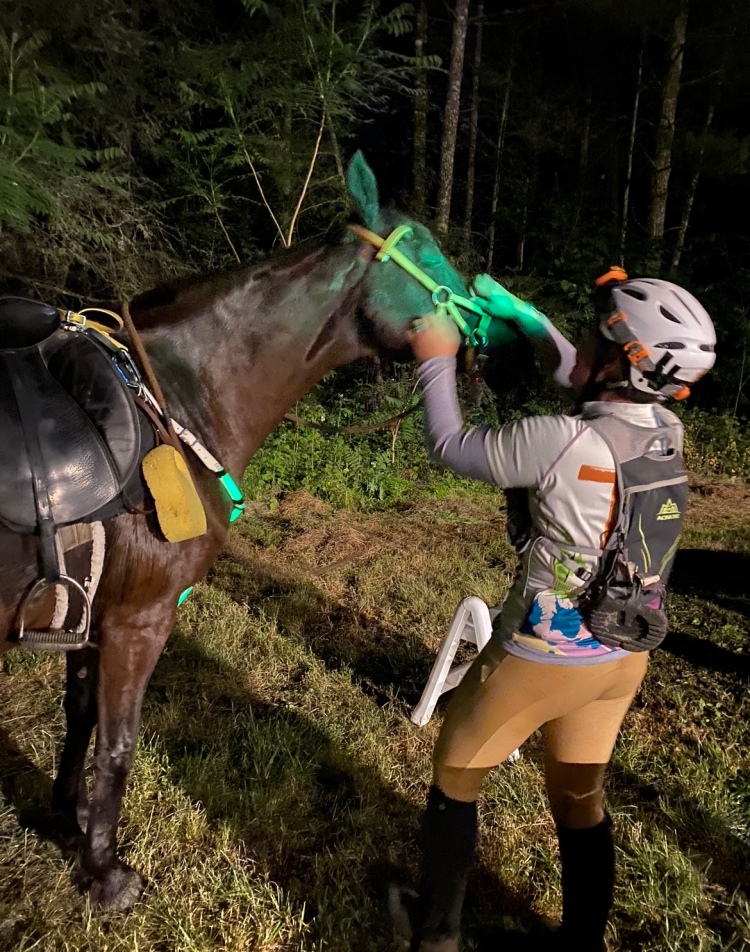
We had now bought a few more minutes and were pulsed in a solid 24 minutes before the cut off. I not only had peace, but felt hope. Regardless we were cleared to Bird Haven, and no matter what happened I would make it to mile 94. And no matter what, that would be the farthest and longest we had ever ridden, surpassing the miles of Big South Fork. Even if something kept us from the finish, I was seeing new limits of the farthest we’ve gone.
Everyone says that the last 30 miles of the OD 100 are “all downhill back to camp” but that is a lie. Danny knows the difference between downhill and uphill, I promise you that. Because that mule can be trotting along at 8mph and as soon as the angle changes enough to tip the scale he puts on the brakes (watch yourself because this could be a trainwreck) and he goes into mule walk. And I can say we mule-walked a lot of the terrain between Laurel Run 2 and Bird Haven 2.
But even the determination of that mule not to trot uphill did not surpass the experience of riding through the fire that was to come in this segment.
Before we left Laurel Run, Diane the ride manager pulled us aside to explain what we were going to find on this segment. The forest fire that had demanded the reroute of the first loop into Laurel Run that morning had continued to burn without significant control from the fire fighting efforts and there was word that it had come upon the fire break that evening. The fire break was at the road we would be traveling home.
She had sent Pete up in the truck to find out the extent of the problem and they confirmed that the fire had come to the break, but it had not crossed it. We were going to find about a quarter mile of very thick smoke, and we would see embers, possibly some burning, but it had not crossed the road and we should be safe to pass. I have to admit I was somehow not surprised.
Of course.
We were ready to go, last two riders heading back onto trail, with an out time of 1:06am. We had until 4:30am to be pulsed down at our last checkpoint (which is the same as our first one that morning). We had 3 1/2 hours to traverse the almost 14 miles to Bird Haven and Nancy was pleased because that was loads of time.
The two things that concerned the fringes of my mind did not include the fire.
First, I have ridden this segment in previous 55 mile rides, and I remember it is NOT all downhill, and it is NOT all smooth sailing road. I remember thinking this segment of trail was deceptively long-feeling when I’d ridden it before. I knew we would be ending the segment with a fair amount of downhill gravel road, which would otherwise be a strength of ours (we can safely and well balanced trot some good downhill) but at mile 90 it was a dangerous risk with tired muscles; the potential for tightening up or a slip-fall meant a place we’d normally make up time seemed like it would be costly instead.
Second, even if the cut off time into Bird Haven was 4:30, that meant an out time of like 4:50 which meant the last 6 miles would have to be done in 40 minutes… which… was not ideal in my opinion.
Regardless, we had made up significant time in the cool of the evening. Everyone had promised me that the hardest parts of the ride were before Big 92 and once you turned out of that checkpoint the horses KNEW they were headed home, and it’s cooler overnight, and the magic kicks in. They begin to gain speed at get faster and more powerful with hope of returning to the trailer, the call of “home away from home” gets stronger as the night wears on. This was not a lie. This is exactly what happened.
Considering how much even slight uphill grade lay before us, we walked a whole lot more of the next segment than made me comfortable, but I wasn’t nearly as perturbed about it. At this point we were on a track and it was going to end somewhere.
I had wondered about the fire section- I had wondered how the equines would react. I had wondered if I would need to convince K to keep going with the smoke? Would she be concerned? Nervous? How would I get her through?
When we finally did come to the increasing smoke, eventually enough to burn our eyes and throats, it had come on so gradually that the animals didn’t seem to have any fear or worries. I felt bad they had to walk through this but in truth it was pretty clear until we were quite close, and then when we did clear it, it was again clear air. I had imagined there would be glowing embers near the road, but I was surprised to see fires burning not far from us as we continued past. I wasn’t afraid, but I was paying attention. We had to walk all of that though it was terrain that the mule would have probably trotted so it was kind of a bummer to have to walk more than already we would need to! We weren’t willing to increase their need for more oxygen while the air was thick, and so calmly we walked.
This segment did feel long (have I written that about all of them??), we wished the road would finally end, and then when it did we had rocks that slowed us down, then a final climb, and then the single track in the woods that I knew would lead us to that downhill gravel road. Still, after all that, we’d have another forest road section that would take us to another dirt road that would after many turns, pop us out to an asphalt road crossing… that was the sweetest part of the ride because once you cross the road where they lay the sand so those with metal shoes will have some traction… that is when you know you’re less than a mile from Bird Haven and you begin to taste the hammock and going to sleep for just a while before the awards banquet where someone will confirm that indeed you and your horse finished and thus win the amazing prize of… a buckle that no one else will probably ever really understand what it represents.
The horses know too. And in crossing that road they were on fire and racing each other to get along the twists and turns that lead to the stream crossing that leads to the pasture that leads to the in-time and your waiting crew!
That stretch we covered in just about 2 1/2 hours which was really not bad at all, and landed us at Bird Haven 2 at 3:37am, directly to pulse with a 60BPM at 3:40am giving us an out time of 4am. This was ideal because I have done the last 6 miles in around 45 minutes in past years for other rides, so 90 minutes is double that… as long as we didn’t end up with trouble at the finish line it seemed certain now we were going all the way.
This hold is only 20 minutes and they don’t require removing the tack, so we did not. I freshened up my water and used the portapotty, changed my socks and shoes (which I’d also done at Bucktail), it’s amazing what fresh socks and shoes can do! I also added a neck gaiter as the chill was beginning to set in, we gave the mare her electrolytes and in no time we were headed back into the meadow this time down the lighted runway heading home. Back to camp.
The last loop both Khaleesi and I were truly getting impatient and Danny knew it! Mules never get impatient I think, they are the most committed and steadfast creatures on the planet. He stopped to takes bites of grass… what felt like every 3 steps but I’m certain I’m exaggerating (I had been up 24 hours now so my estimation is unreliable)… and still he refused to trot up even the slightest incline.
I had told my crew we technically could get back in 45 minutes but we weren’t in a hurry so maybe more like an hour was likely. As the last 6 miles wore on, and Khaleesi promised in typical mare fashion that if Danny paused in mid-trot for a bite of grass one more time she was going to stick her nose right up his mule butt and push him back into motion. At this hour we were slightly less amiable to the stop and start pace that kept giving us whiplash and the drag rider who was not intentionally pushing us, but also riding along behind- would create a small equine pile up behind Danny when he’d stop abruptly and K would end up almost touching his rear and then threatening mortal damage to the horse behind her who was having the same three-equine pile up experience. It would almost be funny were it not after 4am.
Khaleesi had had about enough and was determined to find a moment to pass and take the lead herself, but the mule was way ahead of that trick and he cut her off at every pass- even when I tried to think ahead in my human brain and set her up to take him. We were both just so ready to get this thing tied up at this point we would be glad to let him snack his way wandering back if he would only allow us to trot on along. He would not allow it. I’m sure I’m exaggerating – but my brain was not totally reliable at that hour to have the patience and grace I would on a normal ride in the daylight. At this point I was not actually worried we wouldn’t finish in time, I was simply tired, and had to pee again! So the dragging out of the clock felt more excruciating as I dreamed of the portapotties back in camp!
I remember thinking these two are set and determined to come in as close to 5:30 as we possibly can. I think she must have a bet out there she can time it to cross the finish at 5:29! Do we HAVE to come in right at the last minute? I wondered.
Iva later told me that she never once doubted we would make this ride to the end. She said when she saw us come into Bucktail, she saw Khaleesi and how strong she looked and she said she knew. We were going to do this. That is until she and Mike were waiting with Nancy and Danny’s crew at the finish line… and 5am came… then 5:05 came… and then the other riders who were still out came in… and 5:10 came and went… still no sign of us. She said that was the moment she began to doubt… when 5:15 came and went she began to worry something went wrong.
Then the ding of the alarm went off that warns the possibly sleeping finish line staff that riders are on approach. Iva said there was such a cheer when that alarm sounded as those waiting to see the very last of the riders felt huge relief. When our headlamps and glow sticks came into sight they called us in: come on! You guys got this! Go Go Go!
When we’d finally come out onto the dirt road Khaleesi took her shot to pass the mule and broke into a fast trot. She was in the last mile of her first 100 mile completion and she was ready to fly. I was torn between the fact that we actually were going to be cutting this thing a bit close in the end, I really needed to pee, and not wanting to have a pulled muscle or trip on a rock so close to the end. So I let her go, but not at top speed – I blocked the canter entirely (too risky now). As we came into the camp we slowed just enough to encourage Danny to come alongside and we headed into the lighted finish line together, ready to cross as close to a tie as we could manage.
We crossed the line at 5:19:21am. Eleven minutes on the clock.
Now if it was to become official we needed to pass the vet check. There had already been one finish line pull that morning, so it is real. I handed the horse this time to Mike who walked Khaleesi slowly toward the vetting area where we would pull her tack and get her ready to do the final vet inspection. Iva waited for the rider card to be written on by the finish timer and I got lost somewhere in between unsure exactly what I was supposed to do. I think that was the point I began to cry as I walked to catch up with Mike and K ahead. They looked so perfect walking together with the dim pink light of sunrise coming up before them.
Khaleesi dove for the water trough and tanked up with a big drink. We pulled off her saddle and switched to a halter now that the ride was over. Gut sounds had been a question miles back so I wanted her to grab some grass while we slowly wandered over to the vet. I didn’t want to be in a hurry, and decided not to sponge her because it was chilly in the early morning and she didn’t feel hot even after that last fast push to the finish line. I wanted her to have a chance to get her gut sounds going, but I didn’t want to wait long enough to risk muscles getting stiff and have her look lame due to a cramp.
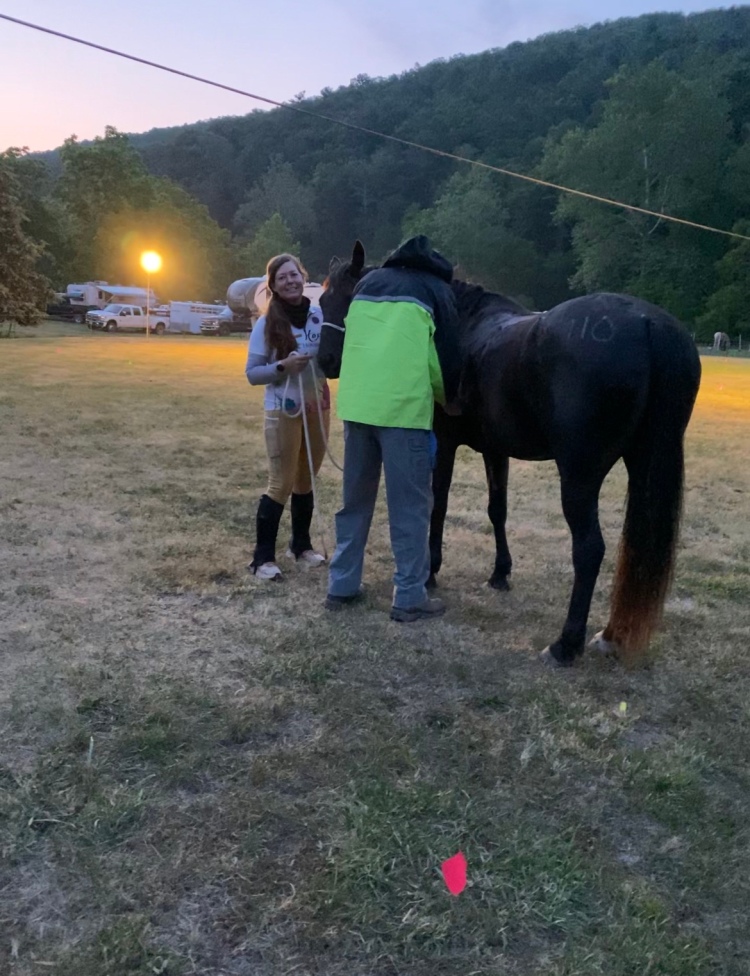
With a slow hand grazing walk to the vet tent she pulsed at 60 with a return to 60 after her trot out. She was completed with all ‘A’ scores, excellent gut sounds, completely sound and even an ‘A’ for attitude.
I had weighed her on the big scale before the ride and she came in a whopping (even for her) 1130 pounds. As we left the vet tent I remembered to stop at the scale again to see if she had lost any weight in that 24 hour extreme feat she had just pulled off. She had lost a mere 50 pounds to come in at 1080. I did not weigh myself… either time! She is at her heaviest of her life right now as she usually weighs in when I bring her to events around the 1000 pound range. She certainly has more flesh than I would like, but she is also covered in muscle and incredibly strong. I look at her and see a mountain climbing beast of the East, my “Athena” athlete. No, she’s not typical in any way, but I’m ridiculously pleased with the depth of what she brought to this ride.
Maybe the true hero of the ride story is actually Danny the mule and his human of grace, Nancy. I know we helped each other through, there were times when K took the lead and pushed the process forward when the mule on his own might have made camp and sat at the salad bar (slight exaggeration) and we had great fun on some of the open dirt roads racing each other playing canter ahead leap frog in the warm afternoon. However I am certain I would not have pushed the clock to the limits that Nancy and Danny were willing to. She never wavered from the certainty that we were going to finish this ride, and do it with the poise and patience worthy of a mule. If I were alone, or if I’d gone ahead to ride with someone else who had pushed a slightly faster pace- I don’t know what would have happened.
Possibly we would have finished 10 minutes sooner (there was a large gap between the first few riders in, then the rest came in I believe between 5:00-5:20. Finishing 10 minutes sooner does not seem worth the panic and rush to me looking back. Possibly I would have had a more tired horse who used up more of her reserve strength and could have been more likely to pull a muscle or trip and injure herself. Perhaps I’d have had a horse less enthusiastic about eating and drinking and could have gotten into metabolic issues. Perhaps… perhaps… perhaps… and all I know is we hitched our wagon to the mule and at least once contrary to my “better” judgement stuck to that commitment and I think it served me more than it did them. That mule’s commitment to taking care of himself gave the space for K to do the same, and from what I observed after the finish line, I have seen her more sore and exhausted from 55 mile rides in past years than I saw after finishing this very tough 100.
Also I feel surprisingly good the day after. I was stiff and sore after the finish line, but after a good epsom salt soak and a good night’s sleep, by Monday afternoon, I was out walking the dogs on our wooded trail reflecting on how little long term physical effects the ride has had on me. I feel a bit like I’ve done a hard work out, but I’ve also felt worse after finishing certain 55 mile rides as well.
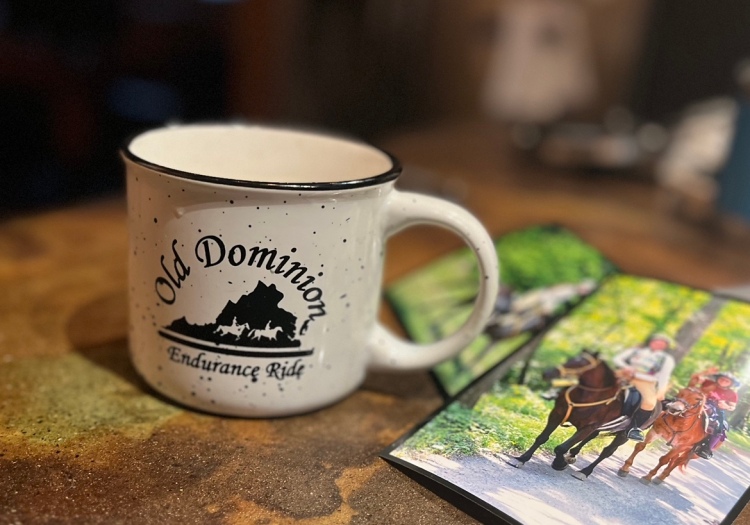
I attribute this to the way in which we rode each segment allowing the horses to set the pace and not pushing them beyond what they were willing to give (yes we sometimes asked, but we didn’t force). Left to my own devices, or possibly riding someone else’s ride, I can see myself using up more of Khaleesi’s reserves. I would have pushed her, especially on places we had clear terrain, and more trotting especially up the hills would have demanded more from her tank of reserve strength. What is stunning to see now is just how great she came through her first 100 and how strong and powerful a horse is really in there.
I have gotten to the place where we can ride some solid 50 mile distances and not have any sign of back soreness. After this ride there is some back sensitivity, and I don’t like that. However I was aware that at every check, when I went to put the pads and saddle back on her, she never protested or tried to dance around or maneuver out of the saddle going back on. Also every time I climbed on a stool, truck or water trough she always came up to me and stood still to mount. I do believe the saddle is dialed in really well- I think if anything it’s the form of my riding as I get more tired. I continually reminded myself to loosen my joints and stay flexible, and as the night wore on I know I wasn’t perfect, but I was riding with awareness and continued relaxation. I also noticed there was more soreness on her L than R sides, and without question I have more tension in my left side. I’m working on that personally but it’s a fact right now.
Aside from that sensitivity where I sat for all those hours, her legs are good, I don’t have any rubs or scrapes or scratches of any kind. The sidepull worked fantastic and I was able to leave it on the entire ride only loosening the under jaw strap to give her more freedom in the jaw to eat in the vet holds. Not a rub or chafe from it.
She was also able to lay down, roll and get back up right after the ride. I have come through rides before she was so exhausted I saw her consider going down and then decide better of it, I think it’s because she was so tired or sore then she probably wasn’t sure she could get back up! That was after last year’s OD 55 actually. That ride took the most out of her I’d seen in a while. Here we were a year later finishing the 100 mile ride in the same place and seeing a much stronger horse at the end.
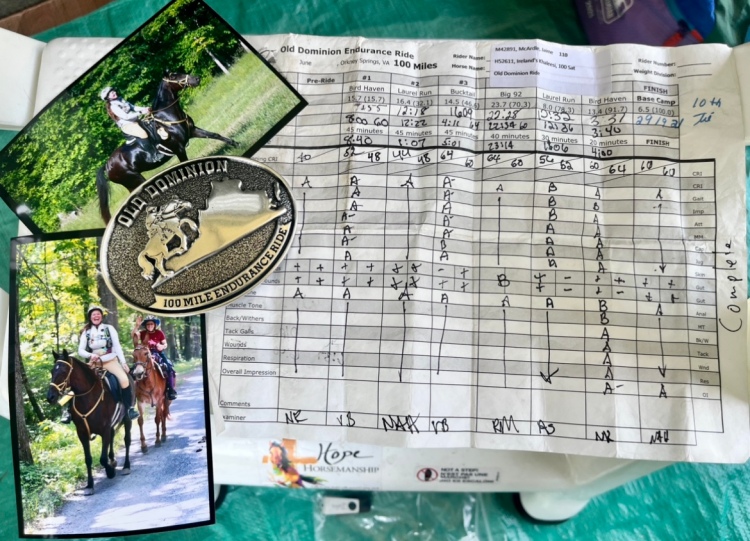
And so we end the story of green to 100 at ride camp. The journey took 9 years, so it seemed fitting in the end we were given 9th place. Not only did she make it through, but she came through thriving in strength. She finished her first 100 in the top 10 which is a bonus for me. True, we only had to finish in this case to be in that group, however there were many people who for various reasons didn’t come to the start of this challenging ride, and then there were 14 who crossed the start and for various reasons not all finished, so I will honor the spirit of the top 10 finish for this powerful horse.
I am incredibly pleased with how we did this, and grateful for anyone who stuck with this story to the end- this blog post which is unusually long, but also our story that began in 2014 with an unremarkable feral little filly who was born on the mountain, on the land, in the herd, and who eventually was taken home by a horse crazy woman who wondered… if it were possible… to finish 100 miles in a day… with this new partner of mine. The queen of the horse people, the mare who agreed to become my partner.
Ireland’s Khaleesi
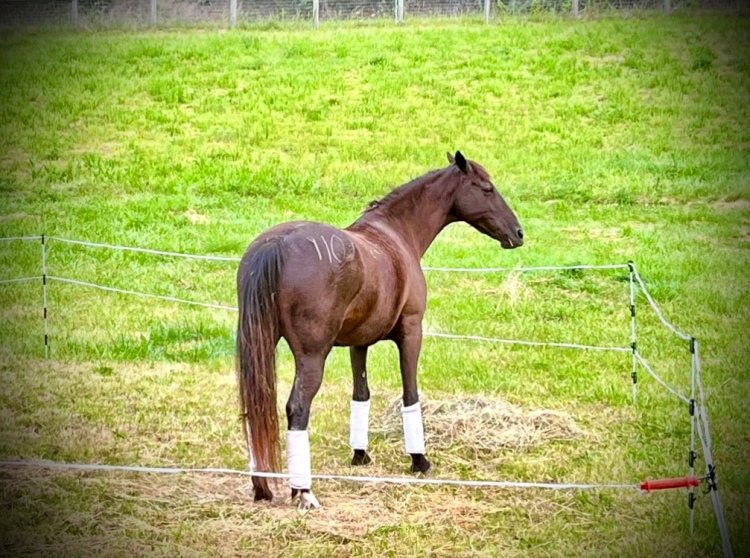
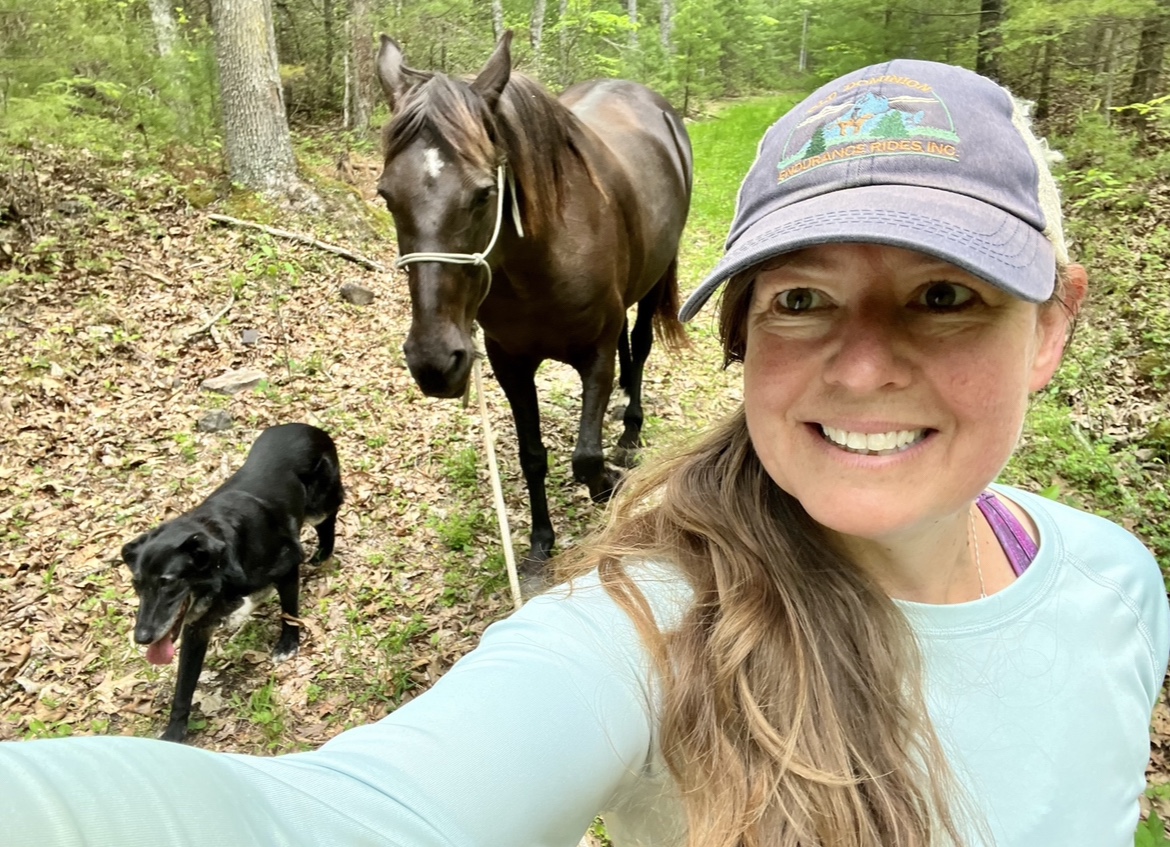
Yesterday was the prep day for packing up… and the last mountain hike for Khaleesi as we pick up speed toward departing for ride camp tomorrow.
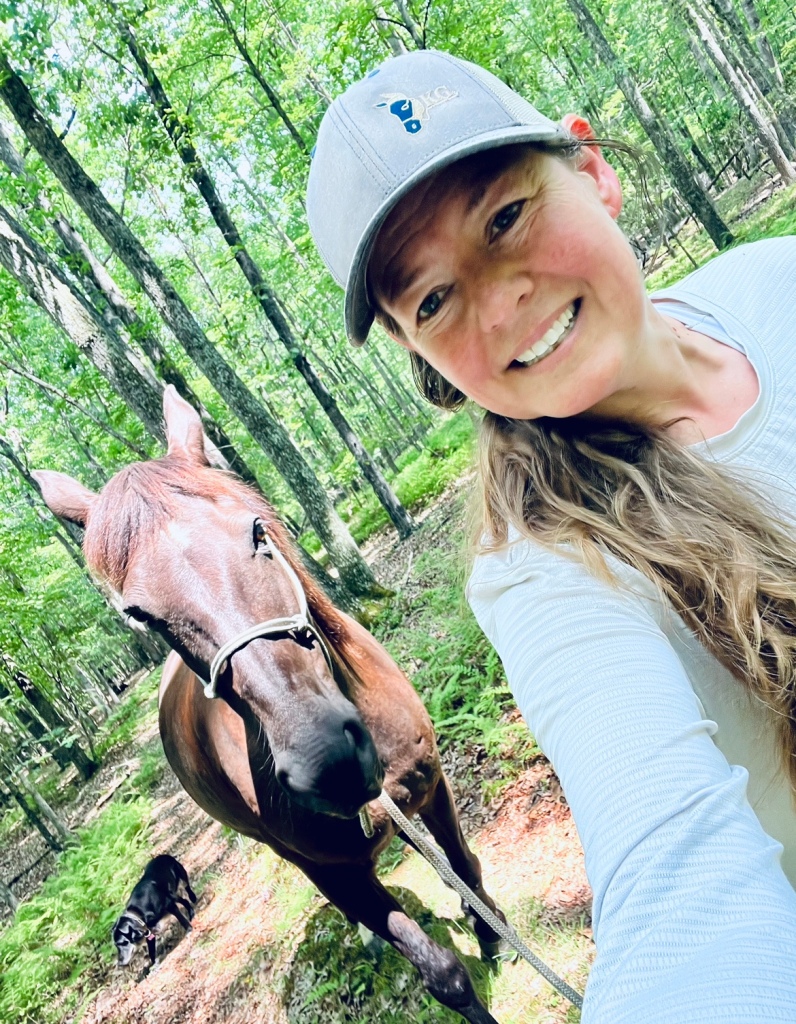
This weekend will be our second attempt at the infamous Beast of the East more officially knows as the Old Dominion 100 mile ride. I remember writing a blog post entitled Love Letter to My Crew and kept thinking I should re-read it, in the very least to smirk at my six year ago self and my first 100 mile attempt quite a bit too early for my horse to do in a way I could feel good about.
A few things have come to mind as I consider the first attempt and approach our second.
This journey… the one that began with an unstarted, basically feral filly I couldn’t reliably get my hands on, to this season where she is reliably finishing 50s— and I think has the foundation built to approach a 100 with the potential to get through the ride— at a cost I’m willing to ask her to pay… it’s been nine years.
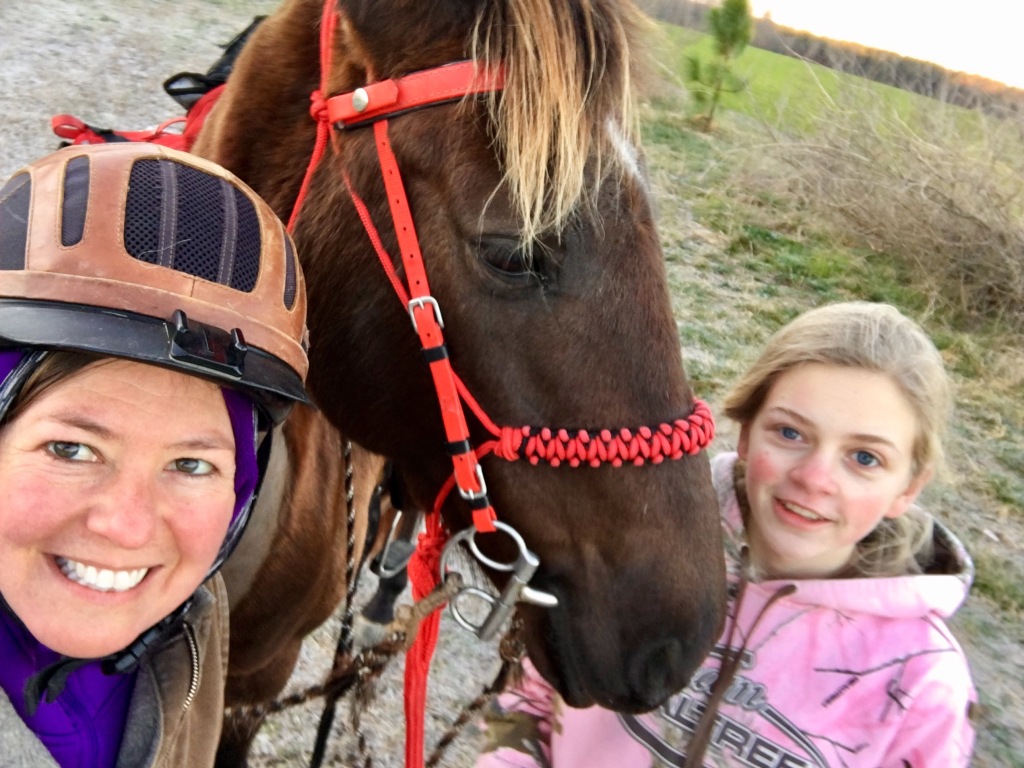
I like considering significance of numbers around me and three is a number that holds an otherworldly completeness. Trinity. This ninth season is three periods of three years, and as I look back, the first attempt came at the third year of our first three-year period. That first period was a great example of the unconscious incompetent (when you don’t know what you don’t know). I had considered my journey to 100 might actually be that simple. Everyone around me said Khaleesi was a great solid horse early in our career, and go for it! She’s ready, it’s just you who aren’t. Honor the horse by jumping in.
Spoiler alert, we lost a shoe in loop one, it tore her foot up, I could have done a hoof rebuild and ride saving measures. I wasn’t willing to do all that only a few miles in. Somewhere in my gut I knew this wasn’t the right time. We pulled. I was no where close to riding that 100 in a way that would honor my horse, and she was no where near ready to do those miles in strength. I don’t know- maybe we could have reconstructed her hoof and kept going, I still think something else would have pulled us out at that point, but I can’t know. I have never regretted the decision to pull her instead.
The next three years, our middle period, were a mixed bag of success and setback. Maybe we got to move into consciously incompetent (when you begin to see more clearly what you don’t know).
Looking back, I can see these were the years of deconstruction. I had to deal with saddle fit issues that were troubling, intermittent lameness that radiographs couldn’t quite explain, finding a good farrier who was wiling to work with the crazy new technology called composite shoes (that ended up being a vital key in our journey), learning to ride my horse in balance, somehow creating a real relationship (oh the failures in that process…), removing inflammation from her diet, I also went through a painful divorce and begin to rebuild my own life.
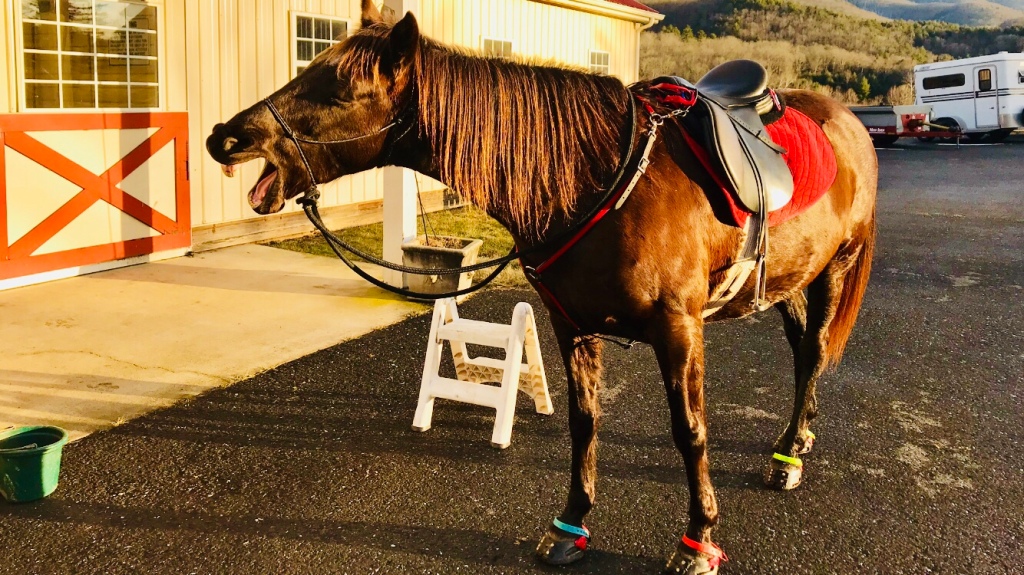
By the time Covid hit in 2020, it seems in hindsight that the deconstruction and death had finally been completed, and I was beginning the third period which was a time of emerging out of the cocoon that 2017-2020 had been. I didn’t enter a single event that year as all the restrictions honestly did not seem like a fun way to spend a weekend- so we spent the time in seclusion putting everything together to re-emerge into the event scene— by 2021 we were rebuilt as a team in more ways than just the horse.
My ace crew Mike Scales and Iva Jamison who are also some of my closest friends and trusted framily were there in May 2021 when we came to a resurrected ride that had been not run for many years at Camp Bethel (thanks Mary Howell for bringing this ride back to life, even for one year so we could also pass through a kind of resurrection ourselves). We finished that 50 mile ride in a return to competition with a solid mid-pack finish (whereas in our first three-year phase we were often turtling the ride and eeking in just under the final clock ticks). Now I had a strong horse, put together to thrive not just get through.
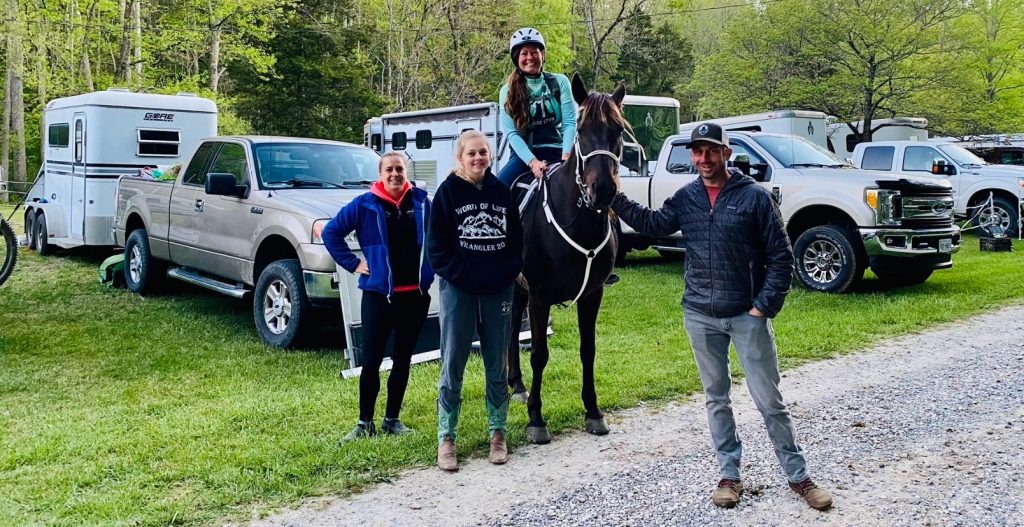
This third, three year period that I am enjoying the last portion of today has been a gift of discovering what makes a powerful partner. The third quadrant of consciously competent. Now we are aware of what we didn’t know and have gotten some good tools and solutions working for us. Being in the consciously competent phase means it doesn’t yet come naturally- it takes effort to plan and function in a positive way- but we are doing it!
We attempted the Big South Fork 100 last September and had a great day. My horse showed me the depth of what she was capable of and we had such joy for 22 hours on the trail (except the whole taking a wrong turn in the dark getting onto a wrong loop, adding 6 miles or so and then running out of time to finish the ride… that was less joyful in the moment, especially when I realized where we were…). We did not complete, but made through 88 miles, and we were healthy and strong. The biggest problem is my propensity to be paying more attention to riding my horse than where we are going… why do I end up off trail or missing a hospitality stop like every ride?! I have to sort that out for pity’s sake… Also I rode the conditions, and the trail was sloppy enough from 5 hours of rain that I just couldn’t move as fast in the dark when we would hit deep mud. The completion wasn’t worth tendon damage or another injury. Regardless of all that- it seemed clear to me… we are close.
How fitting to think it wouldn’t be until the third year of the third of the three year period that we would get to the goal. Of course, all I can do is show up this weekend, it’s far from a guarantee we will make it to the finish and then pass the final vetting. In that case… the journey will continue. I think a nine year journey with the same horse who has shown questionable suitability at times to succeed at this sport- nonetheless the highest level of the game proves that I am stubborn enough to continue until we make it to the finish. It is not a question of it, only of when.
As I re-read the Love Letter posting from 2017 there were a few things I shifted since then. I haven’t fed beet pulp for years. Today, coolstance and hay pellets are our feed with some oats for quick energy. I don’t feed oats unless we are approaching an event, and I add coconut water instead of only regular water now. Otherwise I don’t do anything else different on a ride day than I do every day with my nutrition.
Also since then, I have drag ridden the Laurel Run to Bucktail twice so in 2017 that was uncharted territory, now I know that section and it’s not so bad- in fact it’s one of the nicer loops.
The rest of the post- as I read, I was surprised how much of it I feel similarly heading into this weekend six years later. I am ridiculously grateful to have my “third period” crew Mike and Iva on board for this experience. They were with K and me when we returned to the starting line together at Camp Bethel, they came all the way to TN for the Big South Fork 100 last year, and though I am always grateful for those who support me and come out to help crew (Brandea and Abigail are my hometown Biltmore regulars and you guys are awesome!) but Mike and Iva seem to have complimentary skillsets that are a particularly good mix to really help us get through almost seamlessly!
So this year I have gone a step beyond… no new love letter. Instead I have spent a day in the kitchen and they will get to enjoy favorite sourdough treats: Mike’s favorite organic sourdough chocolate chip cookies (I even doubled the recipe), sourdough discard everything crackers, and sourdough pizza pockets. I’ve heard it said actions speak louder than words!
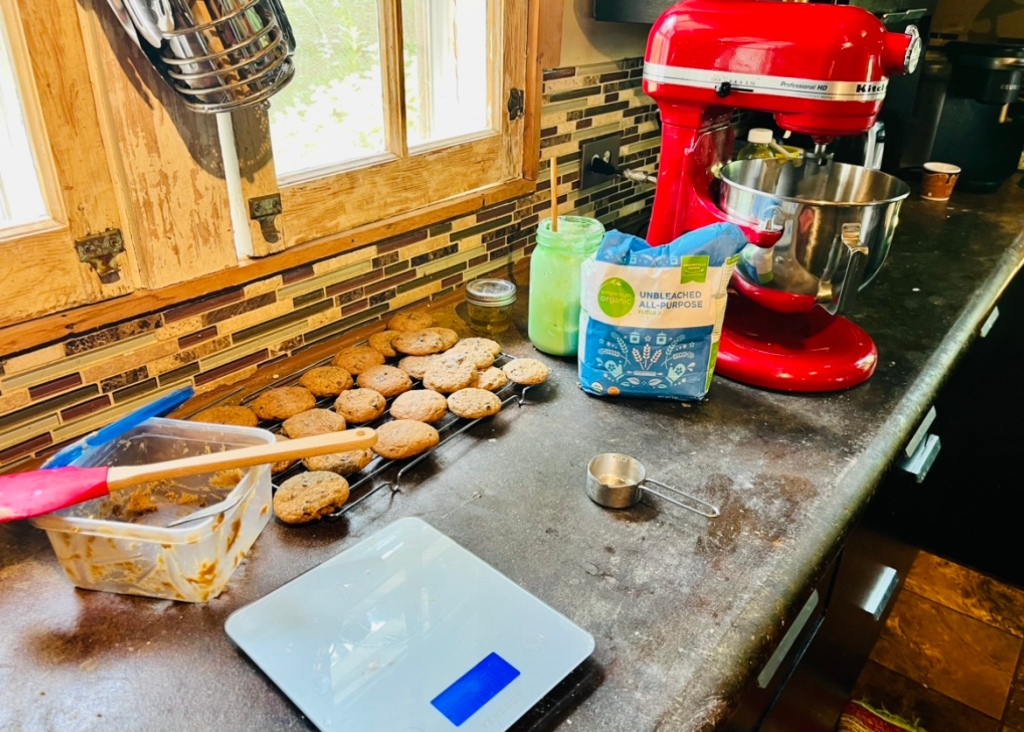
Regardless, I resubmit my love letter from 2017 (click here to read that entry) and we will report back next week with the news from the ride.
Whatever comes… I know it will only keep us growing and take us to new places. Hopefully, someday, we will begin to walk in the fourth quadrant of unconsciously competent, and success will be as easy as breathing and walking. It feels tongue in cheek to even write that since I have to put in much thought and effort to this current phase we are in, but someday, if we just stay in the game, whatever it is, that fourth level should come- first in bits and starts, then more sustained… until there is a true measure of expertise and mastery that becomes natural.
Yes. There is more!
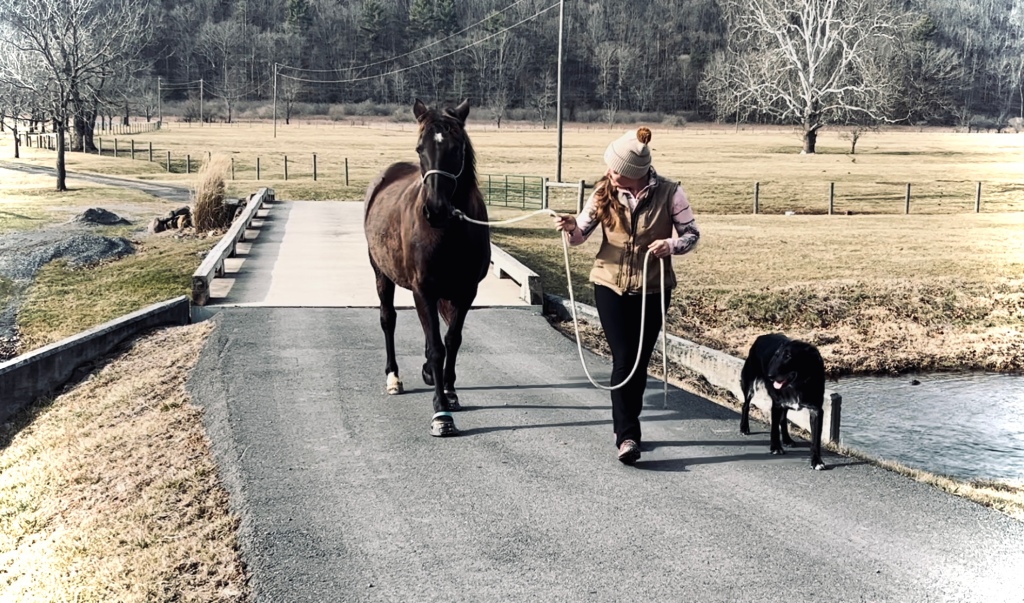
See you on the other side!
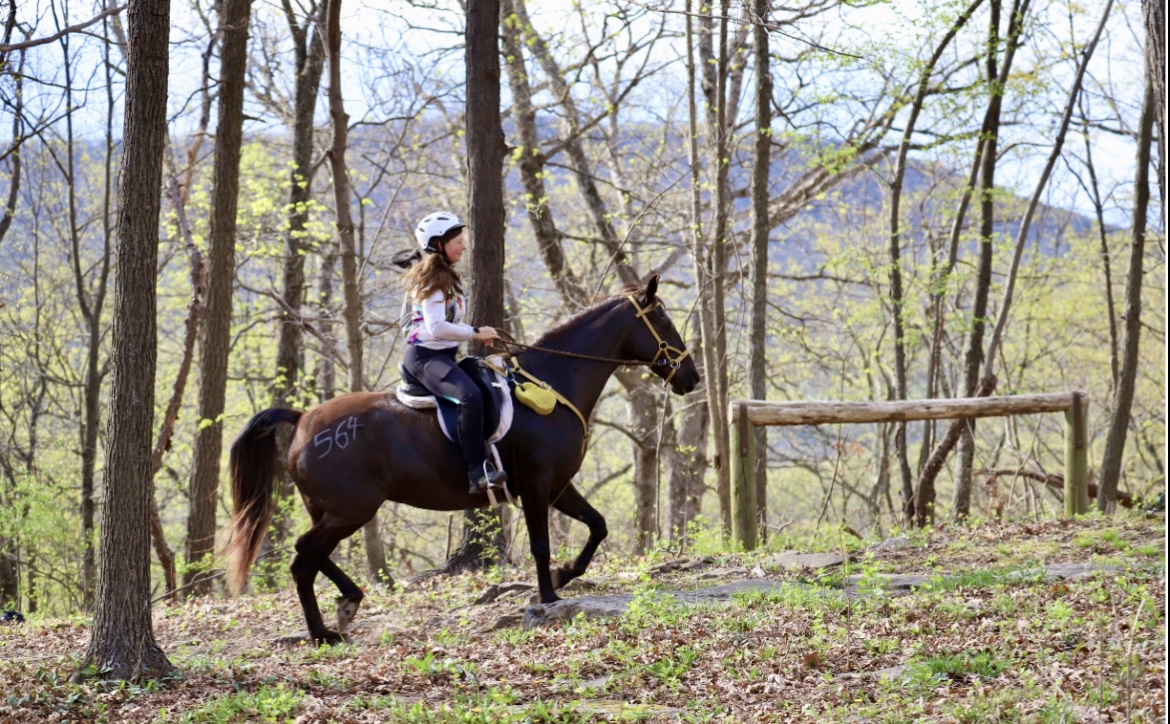
I’ve been holding my ride season plans this year with a loose grip.
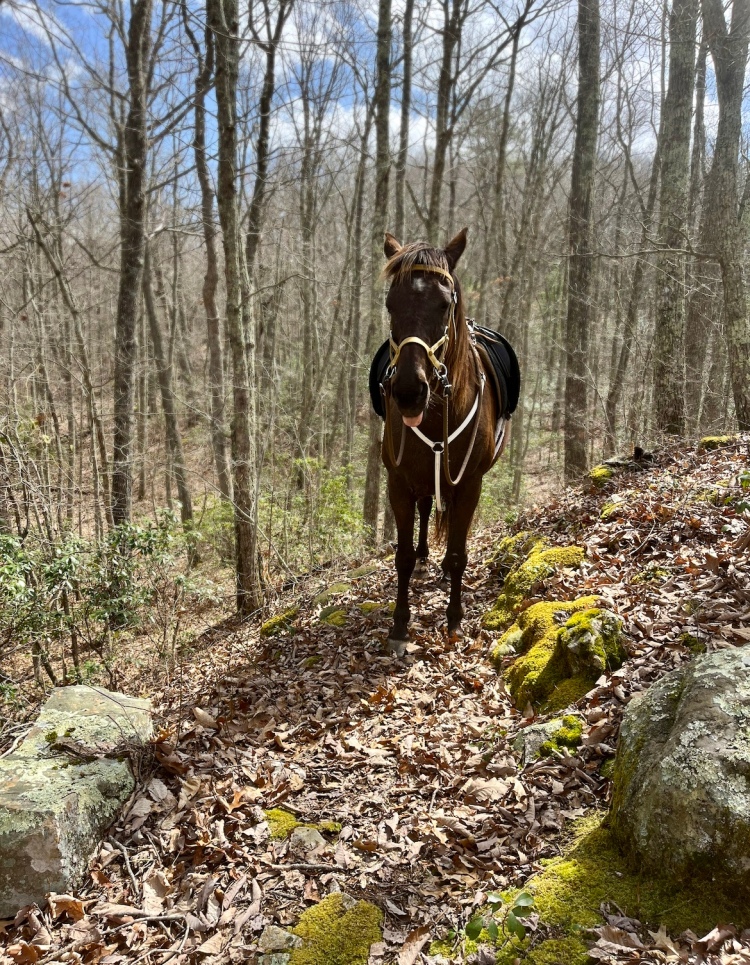
After wrapping up last season with a good ride though unsuccessful finish at Big South Fork (BSF), it became clear we are very close to a successful single day 100. An experienced veteran of the sport came to chat after BSF and encouraged me that Khaleesi seemed like a solid horse, and was wondering: what was my plan for “getting this done?” I didn’t have a plan at the moment only hours after not getting it done, but I asked her for some thoughts.
She highly encouraged me to attempt the Old Dominion (OD) 100 the following June. She took time to explain why she thought it would be a do-able ride for us, and was really encouraging. I was grateful she took the time to share her insight and tucked the ideas in my brain. Over the winter, I decided to give the goal of OD 100 plan a try and we got an early start with the No Frills 55 (which includes some of the OD 100 course) in April, then headed straight (do not pass go… do not change shoes…) to the Biltmore 55 the first weekend of May. My intent going into 2023 was IF we successfully completed those two early rides we would enter the OD 100 in June.
That was until we came through the horrible horrible (“mail trail”) loop in the No Frills ride. That loop felt like it would never end, it sucked the entire life out of me trying to encourage my horse not to stop on the side of the rocky mountain trail and wait for the vultures to come pick us apart. For real… in the moment it was that bad. In that moment I said: there IS NO WAY we are doing the OD 100. Khaleesi hates navigating and climbing the mountains over rocks. This is miserable. For both of us… why would we do this?
Decision made (in the moment of when you should not make any real decision being tired, angry, hungry, frustrated)
We did finish the No Frills 55 and had good remarks from the final vet at how good my horse looked after that grueling ride. This was small consolation, though the finish line WAS the sweetest sight I’d seen in a long time that day.
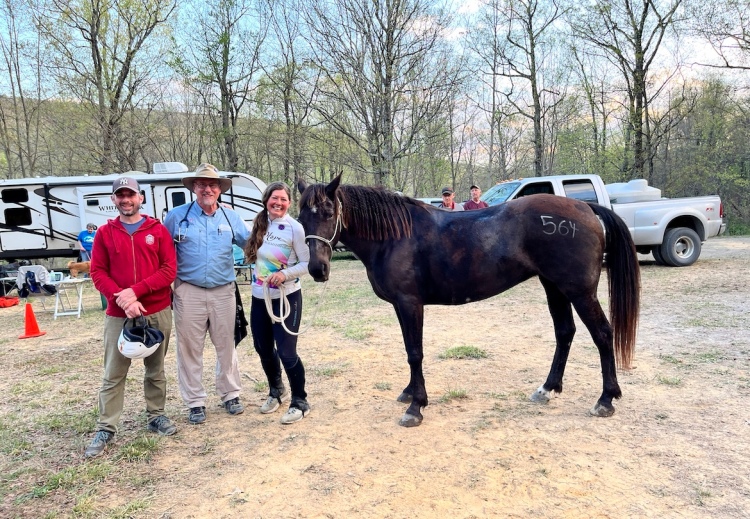
I decided in the aftermath of misery that was the overlapping loop of the OD 100- I had lost my mind over the winter to think we should try the OD 100. So I went back to do what is fun for us… Big South Fork!
It seemed like wisdom to me. It seemed like a good plan to me. I felt… well…
The truth is I’ve never felt very certain about anything this year.
I’ve felt that it will be a good year for us, but I haven’t felt a clarity about what that will look like. I never felt that sure about the OD 100 plan, and when I switched the BSF, I didn’t feel all that much more certain about that. In the absence of “feeling certain” I went with logic. The BSF plan made sense to me in my head.
Recently I was doing some fall planning and wanted to be certain I had the correct weekend marked off for the ride, so I looked at the ride calendar and found… to my surprise, but really, deep down, not that surprised: no 100 mile ride being offered this September at Big South Fork.
Of course not.
If I wasn’t certain before, this helped clarify: If we are doing 100 this year, it is NOT going to be at BSF.
So I weaseled my way mentally for about 2 minutes through other ideas. What about Vermont? I’ve heard that ride is awesome… That just seemed like an overwhelming undertaking- it’s so far, and I think you need crew there as it’s not a return to base camp ride. I considered the new 100 this summer in Southern VA a few friends were looking forward to doing… but we’ve avoided that ride as it’s in the worst heat of August, and in Southern VA it’s miserably hot, and I’ve never really loved the trails or the ride enough to go out of my way… I just did not think that was a good option. Expand my reach? Head out west?
What am I doing?
I don’t want to take on a complete unknown 100. I knew Big South Fork, and the truth is, I know about 70% of the Old Dominion trail from events and a segment I’ve drag ridden twice. I know almost all the vet checks, and I’ve crewed for the ride. The very first ride I ever volunteered for so I could learn about the sport before trying it myself was scribing for the 100 at the side of the King of Birdhaven (Ric Birks) I believe back in 2015.
It probably always was ever since I brought home the feral 4 year old mare. I read an article in our local electric cooperative magazine about a woman who kept trying year after year to complete a single-day 100 mile ride called the Old Dominion 100 and finally her dream came true… I had never heard of endurance riding before that and thought it was fascinating… so within the first week I had Khaleesi in her new home with me, and couldn’t even get my hands on the feral creature in the little pen yet… in the days I could only toss a hay pile and sit in her pen reading a book and drinking my coffee… when someone at a small dinner party asked me a question no one before or since has ever asked (What do you plan to do with that horse you just brought home?) I answered: I’m going to take her from an unstarted and basically feral filly to completing a single day 100-mile endurance ride.

And then I wondered what I had just said, and why I had said it. Because I didn’t even know it until that moment.
So, maybe the OD 100 has always been the plan.
Now we are three weeks away from the day when we will (God willing) cross the starting line for that ride. Though when I think specifically about it I usually want to throw up… I also have a confidence that this is what we’re meant to do, and cross the starting line is all I can be sure of. The rest is going to have to be grace.
The confidence has been growing after I made the call and registered us for the ride (before I could talk myself out of it). I am seeing all green lights for team green to 100.
— First we came through the first two season rides strong. The No Frills 55 wasn’t impressive for time or rank, but she held true to form trotting in good balance the entire 9 miles back to camp on the last loop. Not exciting, but solid. The Biltmore 55 was a nice surprise – we finished in 7th place, and again the horse was in really good shape which is what I need to see. Two serious 55 mile rides with different challenges that she came through with zero back sensitivity, ‘A’ scores on hydration, solid gut sounds, no issues with anal tone (muscles) or a question of lameness in gait. Neither heart rate recovery was exceptional but again- very solid and easily within parameters.
She is finishing these rides with time left on the clock this year with less signs of wear than ever before. Green light.
— Another green light came from the Biltmore 55.
I have been working with Stephanie Carter of Indigo Ancestral Health (in connection with True North Equine Veterinary Services) for a year, getting a picture of what is going on internally. We have done two hair mineral analysis tests and have been addressing any source of inflammation and eradicating it best we can. I hope to have a long career with Khaleesi- and I want a strong, powerful partner who is fully supported in every way I can.
Stephanie helped me adjust micronutrient balance based on what her hair testing showed, and after the second test it appeared that she was improving on balance, but had issues with absorption and her hind gut wasn’t as healthy as we would have expected. I had concerns about iron levels in the well water that is at the barn we are currently residing, so decided to test the water to. I found no iron, but unexpectedly I found substantial levels of chlorine and chlorine dioxide in the water.
I do not know why, and when I tested the spring water in another part of the farm, no chlorine. When I tested my home spring water, no chlorine. So regardless of how accurate the home test is, it is able to show a reading of zero, and a reading of “this is higher than the safety window” for the water my horses had been on for about 18 months.
This would explain why her hindgut was slow to catch up to the changes we had made. She’s had low grade chlorine poisoning killing off the good bacteria needed for a healthy hindgut. I solved that issue pronto, but redeveloping hindgut health takes time and we can support it, but we can’t zap it instantly into balance.
Supporting a performing horse nutritionally is just as dicey as deciding on a good diet for an athletic human. There are tons of opinions and lots of “science” that give us conflicting and confusing information. I’ve felt confident working with Stephanie because I have an underlying belief that simple, forage based, ancestral focused diet, with the addition of micronutrients is what I wanted. I also have a personal bias that human processed foods are causing disease, inflammation and degeneration. And I have come to believe that our animal processed foods are not doing us any favors as well. With the exception of my cat — who refuses to get off the Doritos (and cats get what they want)— I don’t do it anymore. My dogs and horses are on as clean diets as possible with “real” food, and I’ve seen enough of the evidence for this being a game changer that no “science argument” could ever make me unsee what I’ve seen.
At the Biltmore weekend there was a research project on gut permeability in equine athletes and we were given the opportunity to volunteer. There would be blood drawn day before the ride, morning of the ride, after the second vet check, after the ride, and the day following the ride. This is a lot of poking at my horse on a day I need her to focus and not be in a poor mood, but they offered us a carrot so to speak: They would give us a pre-ride and post-ride blood panel. I decided the data was worth the poking, so we enrolled in the study.
In less than two weeks the results came and I looked them over. Except that most of the numbers appeared basically in the expected range, I had no idea what they really meant. Thankfully I’ve been at this “what’s going on inside my horse” thing for a year now, and I sent them on to Stephanie and the True North Team.
I was relieved when the response came!
The team is unanimous! The results are really positive- she is in great shape except some residual inflammation we believe is in detoxing [which we were aware of from the hair test- detoxing happens when the horse’s system is healthy enough to release stored toxins, so is a good sign but does tax the system]. Because she is headed to a strenuous event, lets put her on Organic Gut Solutions [which helps pull toxins so they don’t have to go through the liver and kidneys and reduces stress on the system]. Otherwise keep up the good work! Congratulations!
— Third green light for me, both No Frills and the Biltmore rides challenged our mental connection in different ways, and my aim this year has been to address the disconnect with leading, guiding, and offering instead of punishing, driving, or threatening. I have found myself having to get pretty creative not to get something done the quick way by tapping into my horse’s prey drive which is much easier than offering a better deal and allowing her the freedom to choose. When she is dragging, I’ve seen now that often it isn’t that she’s tired, it’s that her mind was left behind and I need to find a way to bring it back, and see if it’ll engage us forward instead. This has meant a lot of creative thinking in the moment. I’m not sure I have it conquered, but I’m aware of it and we are improving together! I have seen new ground this year in our connection- and the confidence I have that we are a more powerful team is another green light I’ll move on.
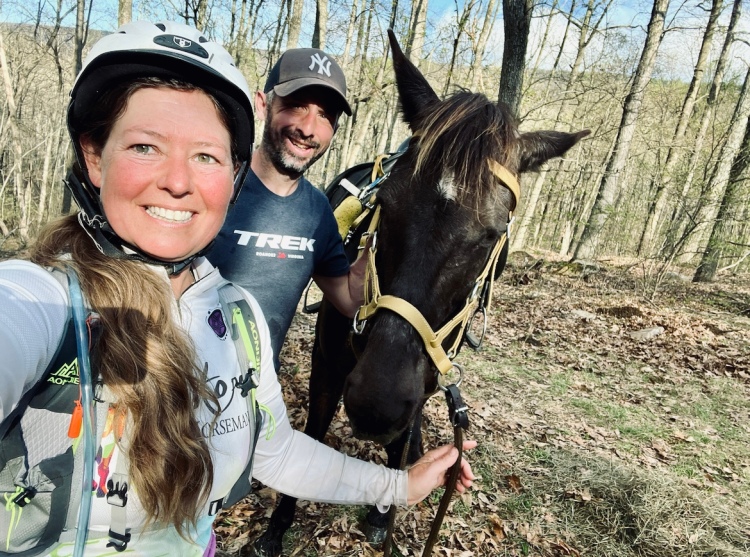
— Finally, I didn’t want to attempt this ride without a crew- and a very helpful green light is that my ace crew Mike & Iva are on deck to support us. Mike has been with K and me since our post-covid return to competition and he has proven to be a god-send. He is also an extreme endurance sport guy (he has done some grueling mountain bike races of just under 300 miles across the VA highlands and set some records doing it on a single-speed). He knows a lot about the physical effects of endurance sports on the human, and has been a great help to me and given me key insights to helping Khaleesi in training and events as well. Bonus: he loves all animals including the horses and they love him too. He understands my approach with horsemanship and is one of the few people I completely entrust my horses to. Iva is quietly steadfast and unflappable. She has been along my horsemanship journey for years and she seems to fill every possible crack Mike might miss on a big ride. They are a good team and to know they’ll be there for me gives me confidence that I’ll have the best chance at getting this done.
So we are in the straight stretch toward the start line. It’s been a long journey and one I’ve hoped could be done in a way I could feel good about. Could we do it in good form? Could I do it not despite my horse but with her cooperation? Could we finish and I not feel like I had just beaten her up to achieve my goals? I don’t know if that will be true, but it has taken this long for me to see the green lights that at least make me think maybe we can.
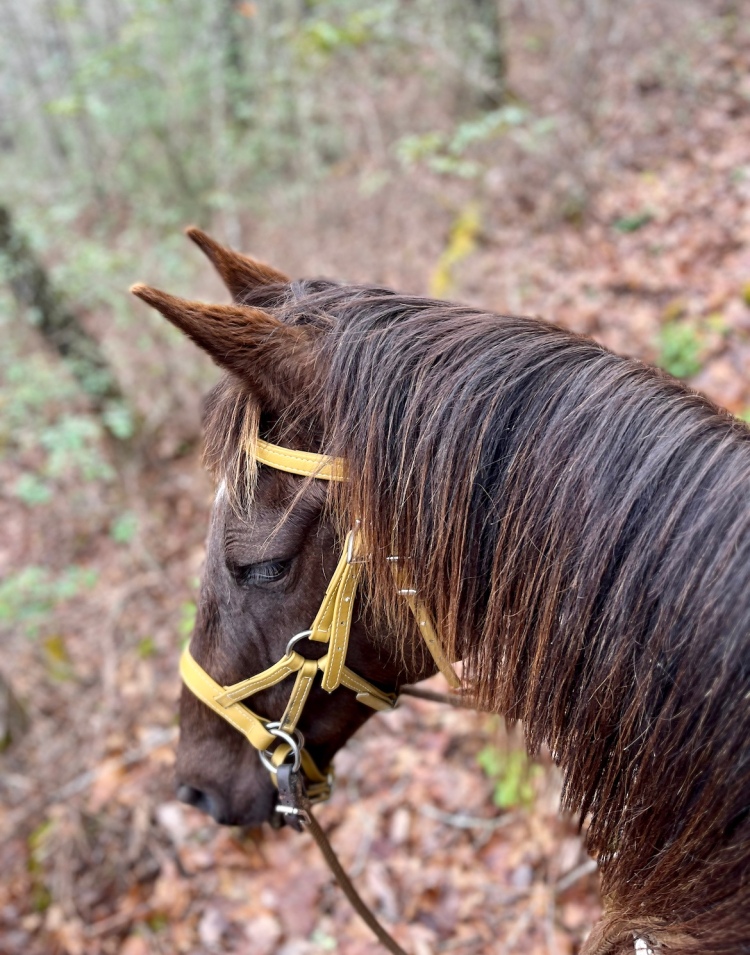
It’s taken years to tweak the nutrition – having a horse who can absorb the nutrients is a huge step I’ve learned; then there’s the support so she shows up to the ride with correct balance and reserves in much needed calcium, magnesium, sodium, potassium etc- we don’t want to play catch up to get through events. It’s taken time to get the composite shoe plan clicked in, the electrolyte balance. We’ve had to get saddle fit solid and up my own riding ability so that we are showing zero back soreness at the end of our 50s, the polarized training and amount of low-zone hiking we’re doing is a huge part of her physical development and muscling especially through the ribs and abs… the experience and experiments of riding in a halter, then a snaffle bit, to landing in the sweet spot of the side pull is a big plus for this season. And I believe one of the most vital keys has been the emphasis on our connection and mental game.
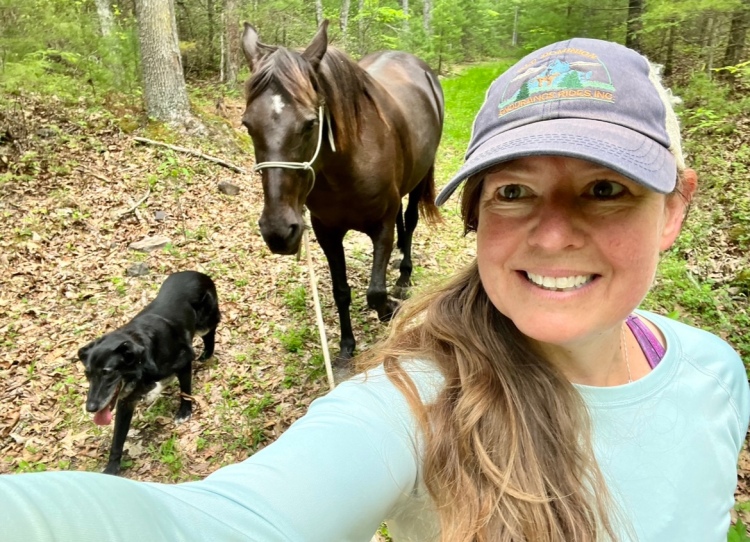
The gradual and patient commitment to finding the balance of as much freedom as I can allow her combined with giving her clear leadership and direction. It’s been a long process trusting her with ever increasing responsibility and that if given the choice SHE WILL come along on her own decision. Increasing freedom generates increasing power- this is a long term play. Relationships cannot be rushed, and trust comes in time. Not only the trust I have in her, but the trust she has in me. On both sides it is easy to violate that trust and go backward- it only takes frustrated moments to feel rushed and the need to JUST GET THIS DONE for months of trust to be eroded in a moment. I have grown personally in prioritizing the long term dream that we can be real partners over anything I think needs to be rushed through when she IS NOT READY and I’d have to use a force card. Today the threshold for this is pretty life and death. We’d need a semi truck bearing down on us in a road for me to go there. At least most days! I am becoming more trustworthy all the time.
We have committed to taking all of these things on in patience. The events are only the testing ground for the work that is our journey together every day. I don’t want an endurance horse, I don’t even care about having a 100 mile horse – I want a powerful horse and a true partner who can do anything we take on together. The events are great at revealing what is being developed.
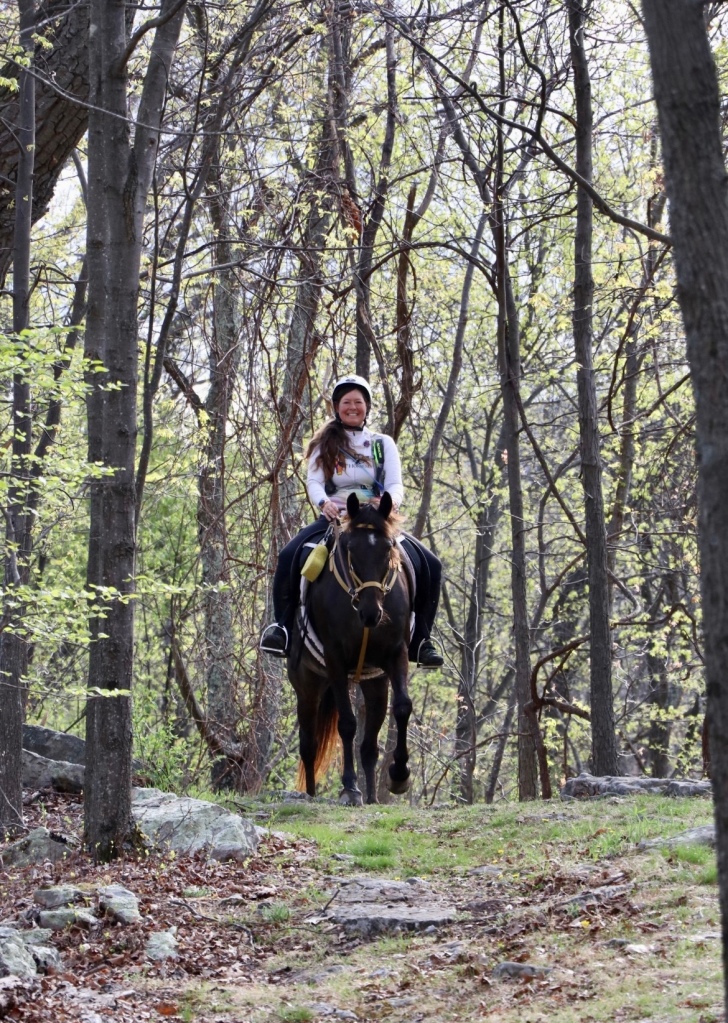
And so… we will show up and I can say for sure, we’ll give it our level best. And we’ll let you know how the showdown with the Beast of the East goes.
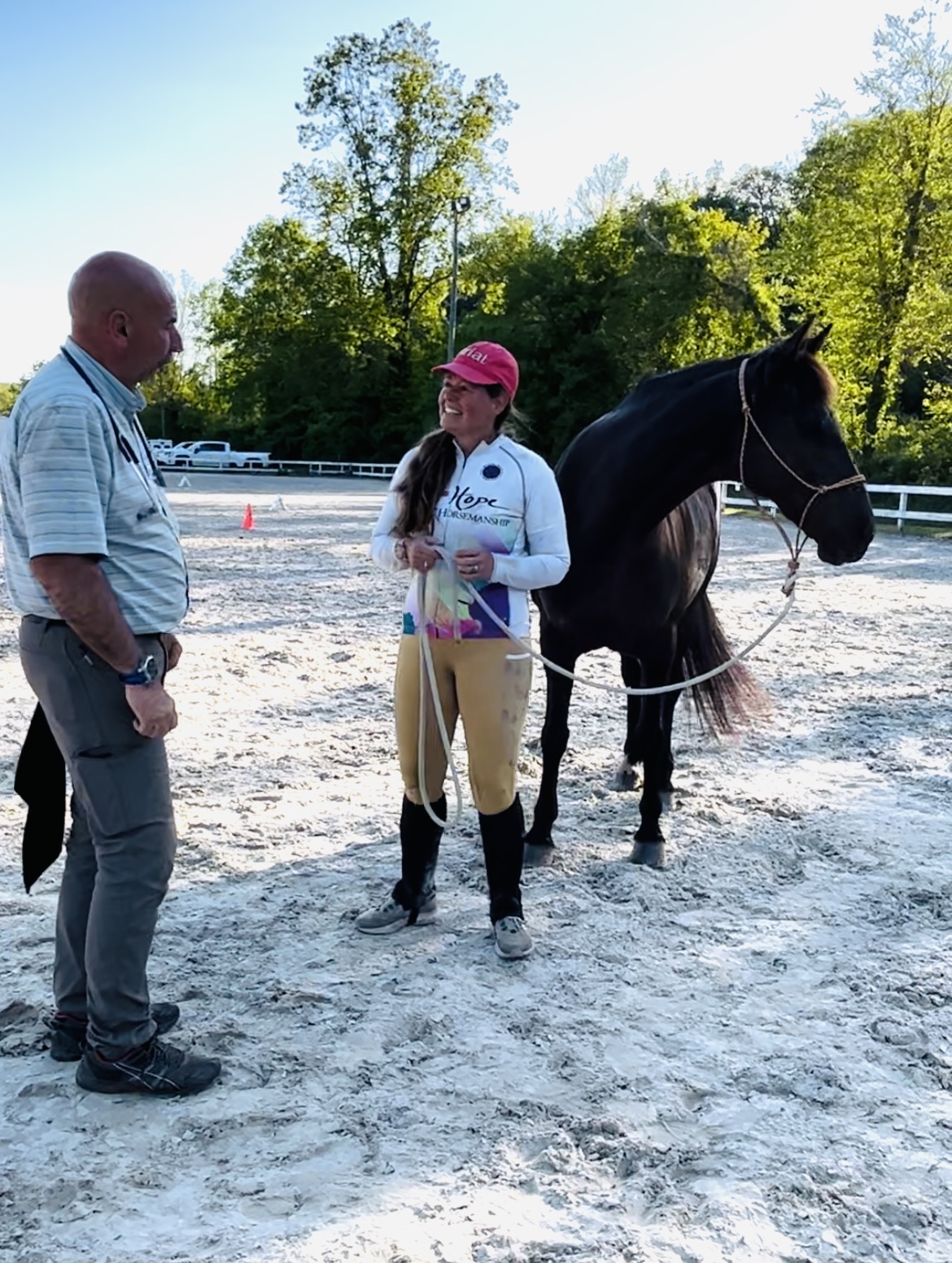
May 10, 2023
I had all the good intentions to give a more details write up from the No Frills ride in mid-April after posting the video clips, but ended up finding more contemplation from that ride fitting for the blog I release through the website for the book I published (The Jael Finishing School for Ladies) — relating to life lessons not usually horse related. And so you could peruse that post here if you were interesting in those sorts of musings: https://jaelfinishingschool.wordpress.com/2023/04/18/giants-for-breakfast/
Meanwhile life continues to pick up on all fronts here at this end of nowhere that I call home and I let the video clips stand as the best representation of how the day went for us in the No Frills 55 for 2023. In short, the weekend was challenging, but we just kept moving until we finished and vetted through successfully for a positive start to the 2023 season.
Before we knew it we were at the door of the Biltmore weekend and hit the road to one of our favorite ride weekends practically in the neighborhood of dear friends Brandea & Abigail who were good enough to drop in to crew. I am so grateful for them- not only are they incredibly helpful around camp and manning the vet holds, but they are family for me and encouraging to my spirit to be around. They are a true blessing!

As challenging as the No Frills ride was, the Biltmore ride was equally smooth.
The start to the trip engaged a mental journey that I have been on for years about what we do with these equine creatures— what we should, or should not do with them. I have considered that they being an animal we invest in, should do what we ask of them- regardless of how fun and engaging they find the work… and I’ve swung at times to the opposite thought that they should only do what they are willing to do without force and given the ability to choose. That side gets difficult because most horses, if given a real choice, are likely to prefer field and friends and food to whatever adventure we have in mind for them. How on earth do I make getting on a trailer that the smart mare noticed had been packed full of event gear for the entire day previous, better than staying with the family and relaxing in the grass?
I have come to a more balanced understanding currently that there are some parallels to a human journey, and without getting too anthropomorphically out of balance I hope (because a horse is not a human); I think we too, if given a real choice, might choose food and friends over a more difficult task that is set before us for some greater purpose if we were honest. There isn’t anything wrong with that, but our human brains are able to decide to take on a thing instead of not getting off the couch; oftentimes there is incentive behind the choice like needing resources (a job), or not wanting to be quite so unhealthy (exercise), or in the best cases answering a need someone else has (love) and so we get out of our comfort zones to whatever extent we will and do the thing before us.
In some similar way I believe that a horse is meant to partner with us humans when done well. Unfortunately it’s often not done well (I am a living example of this at times), and to make an even more complex point, done well can be in the eye of the beholder and have a sliding scale depending on the horse, the human, the circumstance, and the beholder. Khaleesi and I engage in a sport that is challenging and I believe the mare to be equal to the challenge if supported by her wise and honorable human (that would be me in case you’re wondering). And so with greater confidence than I’ve had in previous years of doubt, when she asked me at the ramp of the trailer: do we really have to do this thing? I was able to reply: yes, we really do, and I promise in the end you will thrive and we will do it together, and it will be hard, but we will prevail- whatever comes. And I will do my best to honor you in the journey best I can. Now lets go.
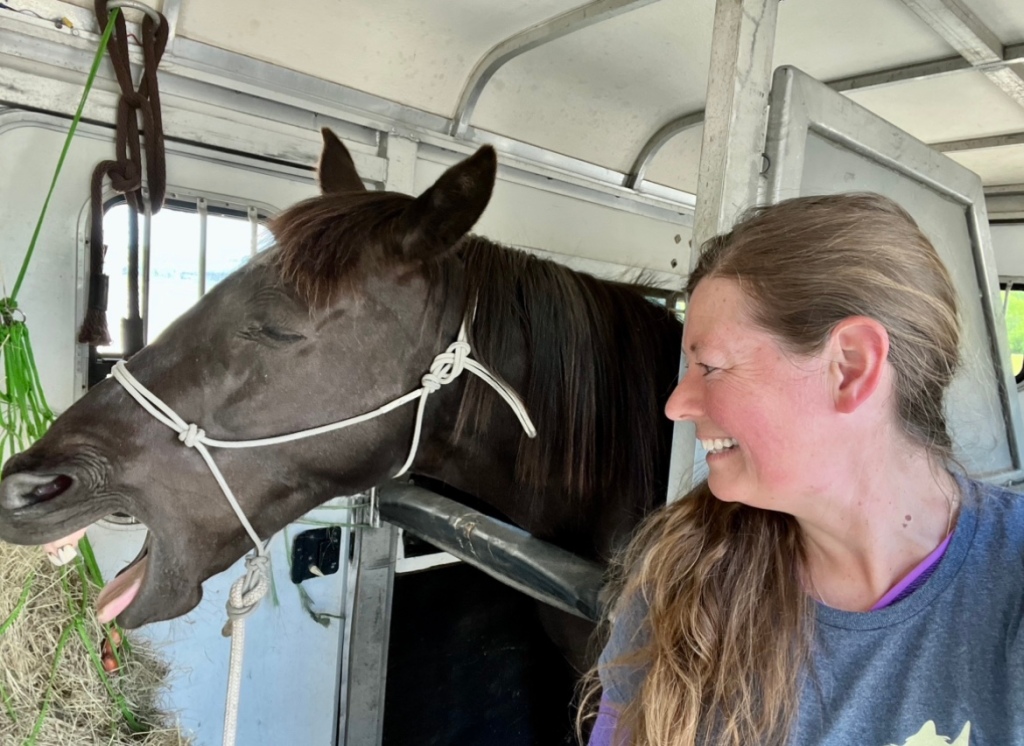
I never arrive early enough to this ride to get a spot in main camp, but I’ve begun to like the relaxed setting of satellite camp. We don’t have designated spaces here and can spread out. It’s a farther walk to main camp and the activities, but that is a small price to pay. Camp is along the French Broad River on the Biltmore Estate Equestrian Center. There was a beautiful full moon that came up while we settled in with our late dinner and except a brief time K was unusually unsettled for a reason we never understood (and after I took her out for a hand walk she reentered), it was an easy lovely evening.
Ride day meant up before dawn getting prepared for the 7am ride start for the 55 mile competition. We all worked together easily to have me in the saddle by 6:30am and heading up to check in at main camp by the starting line.
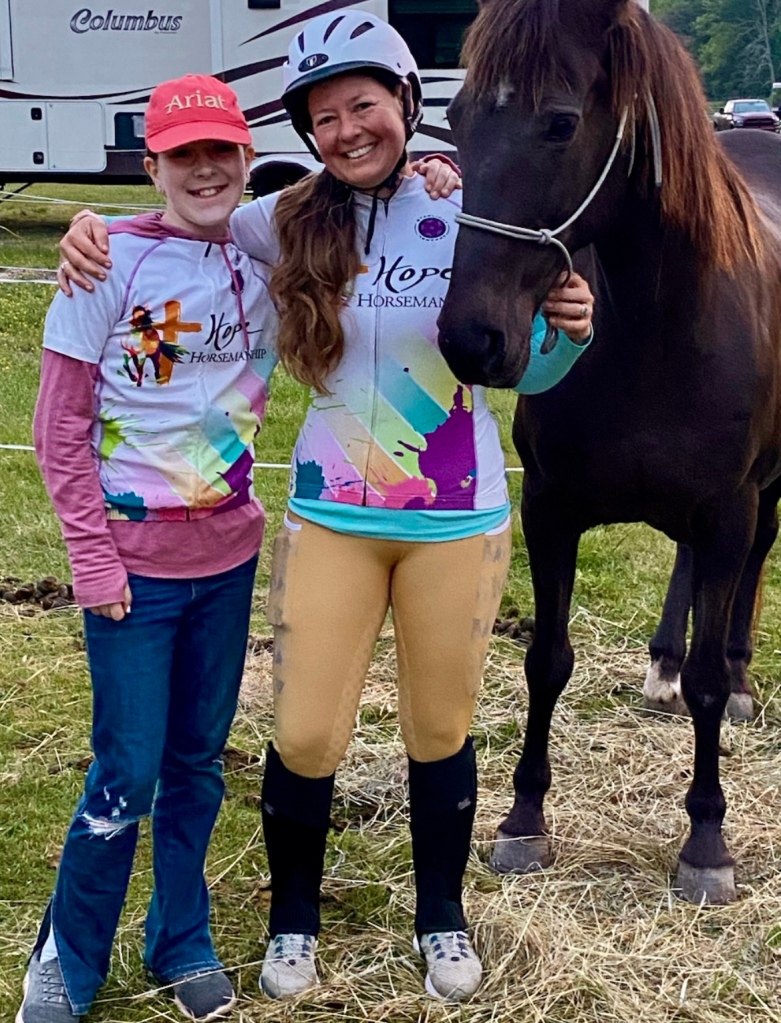
I realize many riders prefer to head out of camp in a leisurely relaxed manner after the first horses take up the immediately open trail. Khaleesi has very little race brain and tends to keep her head about her, we need all the incentive and all the clock time we can get, so I go out as soon as the trail is open for competition. I realize wise counsel often suggests holding the horse back so that later in the day there are yet some energy reserves to tap into. My particular horse doesn’t seem to tap out that deep resource and though she is not naturally a speedy equine, she does have longevity and if I can get some miles knocked out early in the cool of the day, I am apt to take it. Khaleesi is only 1/4 Arab (considering how solid her mind is I’ve had many a joke about the fact that her Arab and Saddlebred halves are not likey the genetics she is most closely associated) We have been known to put money in the time bank in the morning that she draws on when the heat of the day calls up the debt in the afternoon. It’s nice to have the padding.
We finished the roughly 15 mile loop in under two hours with an average speed of 8 mph. She didn’t feel exciting, but was solid and strong. Her pulse was down at 56 by the time we got the saddle off, and we had no trouble with the vet or the hold.
After the 50 minute mandatory hold we headed back out for the second and longest (22 mile) loop. This loop she was mentally not interested in going out to ride. I find it revealing that when her mind is not engaged in the work she can convince me she might die… Yet when we were overtaken by a small group of horses about six miles into the loop, she was clearly inspired and indeed she had plenty of life in her. It’s normal for us to ride the majority of an event alone, but the Biltmore has so many people doing various distances on various overlapping trails (25, 55, 75, 100 miles) we often rode along with people even for short stretches of overlapping trail.

This is one valuable key that has been in my mind for months. A horse will only perform as well as her mind is in the game.
Since meeting Harry Whitney in February, when he talked about mental lameness, I had an “aha” moment about a strange phenomena I see on occasion that has, in years past, concerned me for a physical injury. It’s the mystery lameness that is hard to duplicate. Occasionally now, I can connect with times she is not thinking forward down the trail, she has this hop that comes in the trot that feels like she is going off. It shows up less and less over recent years, but I have still noticed it from time to time. Harry shared some experiences about similar strange gaits that no vet could sort out and no constructive farrier work could address; when he began to work with the horse focused on sorting out the issues in the horse’s mind, the lameness or gait dissolved and the horse came right. Now if that strange little gait appears I address it as a mental problem- her mind is somewhere else. I am not suggesting she is trying to trick me into thinking she is lame I am saying she is thinking backward, behind her where she left her mind at the trailer, at the barn, in the field or at camp, and the forward motion I am physically insisting on is in conflict with where her brain is. This can show up in a strange gait where the two worlds collide in an off-kilter hop that feels like a lameness. In short- the horse has lost her mind, and it’s my job to try to reunite them but getting her mind present with our bodies (because I’m not heading back to camp to retrieve it!).
So I begin addressing her mental state which is not so simple to write about in a blog, and I’m still getting more proficient at, to encourage her to get with me, get her thoughts moving along the trail, and get back to work. When that happens the strange little hop gait does not reappear.
We finished the second loop in just under three hours with another smooth vet check and hold. Average speed for that according to the GPS was around 7.5mph which is pretty good for us.

The final loop is the long 18 miles. It’s long because it’s in the heat of the day, repeating the exit and return to camp trails, and though she was more willing this round to leave camp alone, she was not particularly enthousiastic about it. I have found myself in this same place from time to time in life- the job is not too hard, but it is bit tedious and so we just keep moving through without gusto because it will eventually end and the only way to get to the end is to go through. And so I reminded her to keep trotting, even if it’s slow, we just finish this last loop, and then you can relax, eat all you want, and take a nap. This loop she took a slight bit longer than the second, but an average pace of about 6.5mph which was respectable and got the job done.
In the hair mineral analysis testing over the last year, her adrenal levels have suggested that she is a horse not prone to speed, but to endurance. It seems it’s preferable to have them more balanced, but considering this sport is endurance, and considering my hope is that we are able to compete the single-day 100 at some point, maybe I have just the right creature for it after all. I have noticed that she may not be flashy, but she can keep going. All through the day she reminded me of the energizer equine so to speak, she just kept going. Balanced, solid, true to form, steady, trotting along in a regular rhythm.
I have been working on polarized training with her now intentionally for about a year. I do notice a difference in the events we do. It worries me just a little because I do not feel the energized quickness I feel she had sometimes in years past- but that did not last all day. Now it’s less remarkable and exciting, but I am finding a depth that shows up to replace the eagerness I’ve felt before. So far it’s a depth that has served us until the finish line and I haven’t come to the end of it. I have been told this kind of training builds an engine. I have felt the freight train in times past, and that is exciting, now as we ride through the miles with less excitement, I felt instead the little engine that could. Less like the impressive bullet train, and more like the work engine that is dependable to carry the load across the miles and keeps chugging along though the changing scenery without faltering. She just keeps going.
When we crossed the finish line I was surprised to see we had finished in 7th place (out of 33 starting that morning). The ride did not feel particularly victorious as we went through it, and 7th place bumps us into the top 10 group which we are generally just out of (our usual finishes are in the teens, generally solid mid-pack).
Next we had to pass the final vet exam or the placement meant nothing. Once again this was smooth. I was particularly pleased how well she came through. In the last few miles I felt her begin to slow on steeper downhills taking more care, or she would slip on occasion which told me she was beginning to tire. I wondered if she was getting tight muscles from the constant up and down of the Biltmore trails. I also felt personally exhausted from her somewhat jarring trot (she has a decent trot, but it’s no western pleasure jog) and we’d been at it all day with very few intervals of cantering and even less walking. I try to sit the trot as often as it’s possible because of an imbalance I’m working on with her trot diagonals and a one-sided strength I built in years previous. All this to say, I also wondered how her back would feel from me attempting not always successfully to not bounce around on her yet stay loose and give her body the ability to move in the freedom she needs to work in strength and efficiency. Though I have come a long way, my riding still has room for improvement and I do get tired over time.
In the final vetting, I watched the vet (Ken) pressing all around her looking for any signs of pain or discomfort, and I was pleased to notice her relaxing into all the poking, prodding and pressing as if it might be a massage. Not a sign of back soreness and he gave her ‘A’ scores on muscle tone all around. Her legs were in good shape, hydration was an ‘A’, and gut sounds were decent (one quadrant was a “minus” the rest were “plus”).
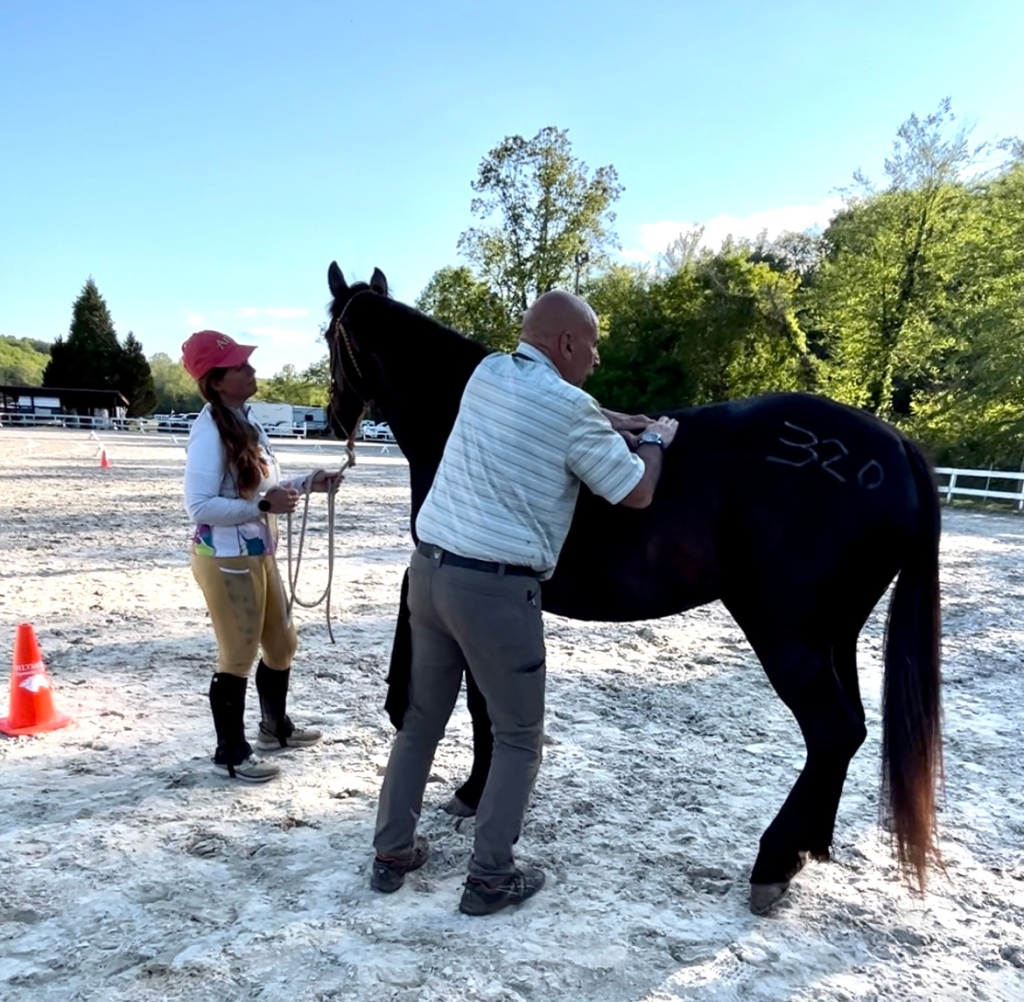
She had eaten herself along the entire last loop which had been at times annoying for me trying to keep moving but I was glad to know she was feeling good because an exhausted horse will lose interest in food. Not only did we pass but he gave us a time to present for “Best Condition” which would be the horse that came through in the top 10 and finished also very strong. This would be our first time to show up for that potential honor and I was glad for the experience.
Once again: the mental key.
I knew my horse was in good shape and she spent the time window waiting for the best condition appearance eating grass and being brushed by Abigail who since we were not at our campsite used her own personal hairbrush. She was determined to ensure Khaleesi was well groomed and looking fabulous for the moment. Thank you Abigail, your efforts of caring for K through the day were over and above!

When we went to present it was in the very fancy dressage arena with the very expensive footing that had been closed off to general use. There was not a way we could have gone in there beforehand, nor did I consider trying. We entered and the examination began showing basically the same things the initial exam did- she was in good shape. Then we had to trot out and back, and around a large circle in both directions… Seeing the movement of the horse is a vital part of the scoring process and this is where I saw the mental part break down.
As we began to move through the arena which was littered with cones and other arena paraphernaliaa… and on the other side of the arena fencing were tents with vendors, cars and trailer and trucks moving about and in this slightly new environment my mare’s brain went all over the place… what is that white thing? Did that tent just flap in the breeze? Will it fly over here and crash into us? Where is my human going? Oops, I almost ran into her… oh! I just stepped on the orange cone and smashed it into the expensive blinding white footing… hey, she is running back now… better follow along or I’ll get yanked by the lead rope… wait, a circle, she’s changing sides- did I just almost hit her head with my chin?
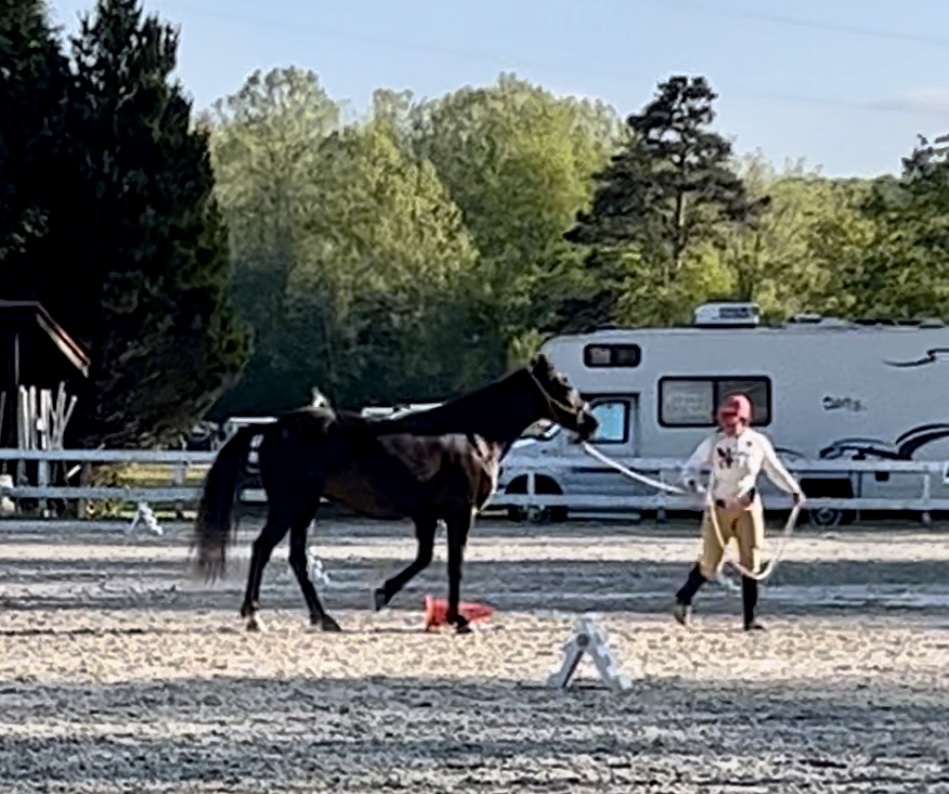
Oh yes, this is what our presenting was like. Considering I know what my mare can do when her brain is present- and I was not able to bring her back in that exact moment and do what we were called upon to do I had to laugh. It is good to see new things to grow into ahead of you.
On the point scoring side the fact we were about an hour behind the first horses to finish even if we were in fabulous shape we’d have to be exceptional to have taken this award- but the experience was really good for us. Ken was incredibly kind and lighthearted- first telling me that running over the cone is immediate disqualification which then he laughed and said of course not really… and he gave us great insights on how to present the horse at her best next time. He told us that considering we may find ourselves in this position now more often, we should practice and be ready.
I suppose time will tell.
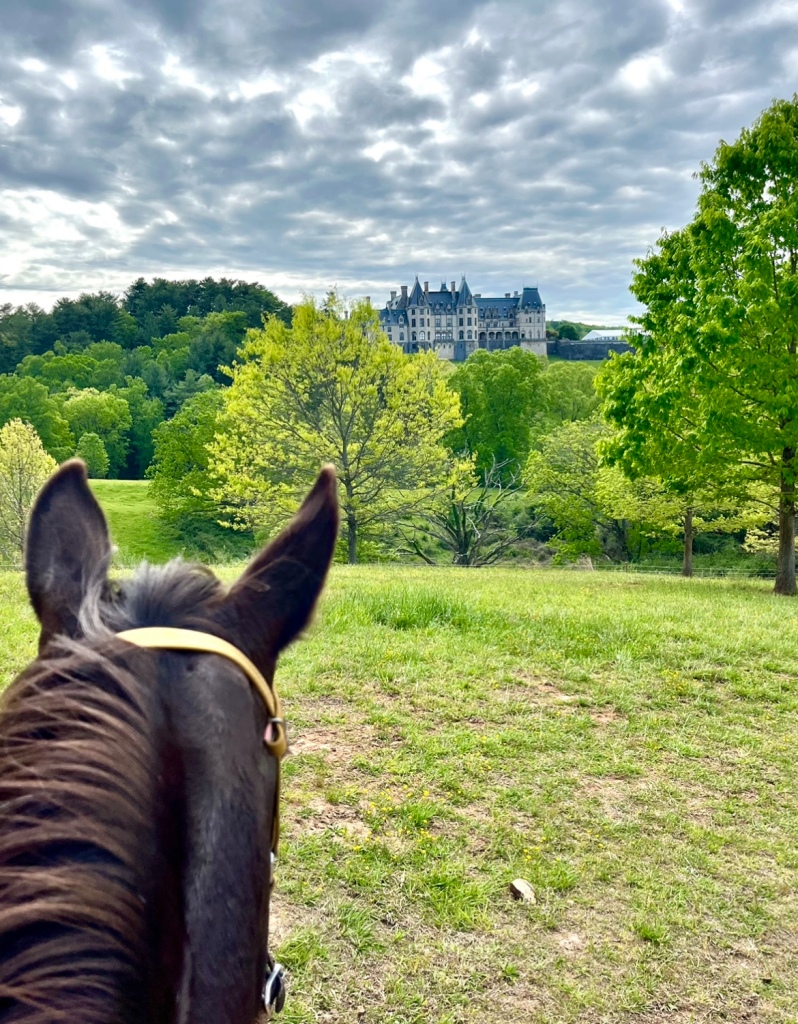
Regardless of where the path takes us on our journey to the single-day 100, I am grateful for the gift of a highly successful ride. I became aware after returning home that it as seven years ago that we took our first ride to the Biltmore to try for our first ride in the “50-mile” distance (it was a 55 mile) and this ride, seven years ago was our entrance into this sport’s foundational distance. Previously we had done the “Limited Distance” categories of 25/30 mile distances. Seven is a good number. It often symbolizes a completion (a seven day week…) sometimes a promise (seven colors in the rainbow)…
I am hopeful that the things we have spent years putting into practice, and believing that with patience in staying the course even as the improvement was slow, they would create a powerful horse that would continue to get better and not break her down for a relatively short career window and a horse with chronic injuries in the middle of her life. [I explain some of our foundational pillars in the post Top of the ninth if you want to go back to read it]
My hope is this commitment to doing things the slow, patient long way are beginning to bear fruit for us. I am excited about the key I believe gives access to all the important doors, the mind, and I’m looking forward to how increasingly learning to work this key will bring about more and more strength in my mare.
As a post-script, the other key from this weekend I believe, will come from our willingness to volunteer for a study that was offered. Blood and feces were taken at intervals to research the potential of gut permeability (leaky gut) in equine athletes. While the results of the study itself may take some time to see, each participant is getting a personal blood work panel including “a complete serum biochemistry panel including electrolytes, muscle enzymes, kidney values, and lactate before and after the race” which will come within 10 days of the event. Considering we have been working on the internal functional side of the horse for a year now addressing nutrition and whole health (including gut health and potential inflammation) I am really looking forward to what the blood work before (which would be “normal” for us) and after the ride tell us, and how that might instruct any changes to supporting Khaleesi both day to day (normal) and during a race.
Meanwhile… we relax a bit this week and try to get some early work done as we have a month until the Old Dominion weekend in June.

Thanks for coming along for the ride… until next time…
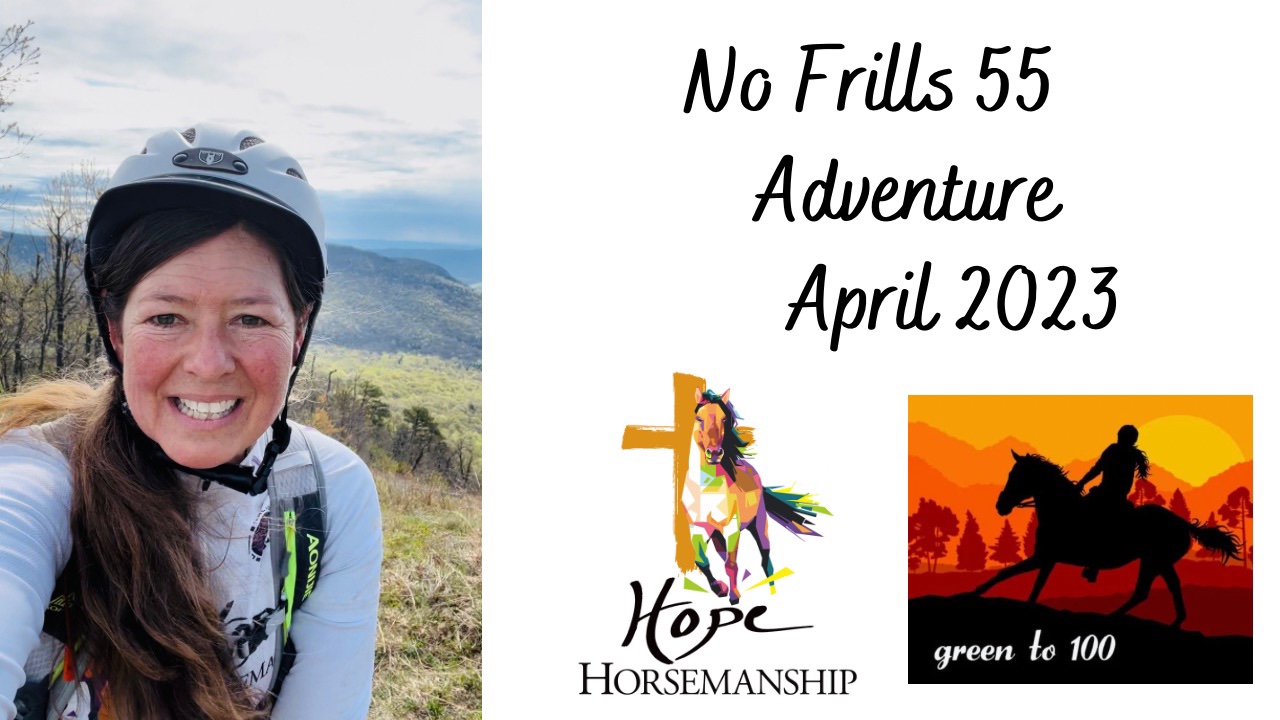
I definitely learned some things on this ride that I’ll get a better write up on…
In the meanwhile enjoy this 10 minute wrap up video and come along for the adventure!